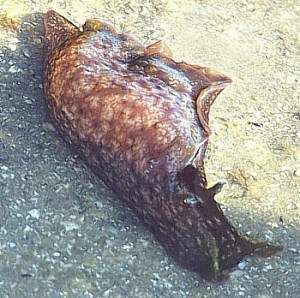
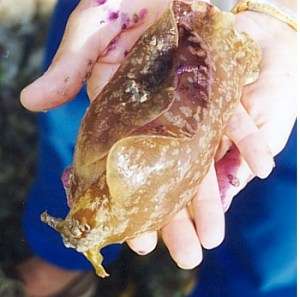
Aplysia brasiliana
Rang, 1828
Order: ANASPIDEA
Superfamily: APLYSIOIDEA
Family: Aplysiidae
DISTRIBUTION
Atlantic Ocean. West Atlantic from New Jersey in the north to Brazil. East Atlantic from St Helena and Ghana in West Africa.
PHOTO
Captivia Island, west coast of Florida, USA, March 1999. PHOTOS: Anne Dupont. (See Anne Dupont's message below).
RELATED TOPIC
Note added 25 March 2004: See message #12545 proposing that A. brasiliana is a synonym of A. fasciata
Relatively large swimming Sea Hare growing up to 27cm long. Very variable in colour. The background colour can vary from translucent yellow, brown, gray, green or black, usually with irregular patches and mottling of different shades of brown and green, and often with lighter spots of white or yellow. There can also be veins and streaks of black or dark brown.
Reference:
• Eales, N.B. (1960) Revision of the world species of Aplysia (Gastropoda, Opisthobranchia). Bulletin of the British Museum (Natural History), Zoology, 5(10): 267-404.
• Marcus, Ev. & Marcus, Er. (1955) Sea-hares and side-gilled slugs from Brazil. Boletim do Instituto Oceanografico, 6(1-2): 3-48.
• Marcus, Ev. & Marcus, Er. (1957) Notes on Aplysia. Boletim do Instituto Oceanografico 8(1-2): 3-22.
• Marcus, Ev. (1972) On the Anaspidea (Gastropoda: Opisthobranchia) of the warm waters of the western Atlantic. Bulletin of marine Science, 22(4): 841-874.
• Susswein, A.J., Markovitch, S. & Achituv, Y. (1993) Asymmetry of male and female mating in mixed-species groups of Aplysia fasciata Poiret and Aplysia brasiliana Rang (Mollusca: Gastropoda). Israel Journal of Zoology, 39: 213-229.
• Wirtz, P. (1998) Opisthobranch Molluscs from the Azores. Vita Marina, 45(1-2): 1-16
See Anne Dupont's message and my message for discussion on whether the animal photographed here is A. brasiliana.
See Paul Hamilton's message confirming its identity as A. brasiliana.
See the Sea Hares Page for more information on Sea Hares.
Rudman, W.B., 2001 (March 9) Aplysia brasiliana Rang, 1828. [In] Sea Slug Forum. Australian Museum, Sydney. Available from http://www.seaslugforum.net/find/aplybras
Related messages
Re: More swimming Sea Hares in Florida
May 3, 2010
From: Michele Harrison
Concerning message #23554:
I am sitting on my boat, the FantaSea at South Seas Resort on Captiva, and these little creatures are swimming all over. I saw them here for the first time last year but seems they are in abundance this year. Sea Hare, Ink Fish, whatever they their names, are graceful and delightful little swimmers, surfacing with every breast stroke. Between these little guys, the manatee, and dolphin, I cannot imagine a more perfect place to be but here on Captiva! The sun is just setting and the breeze is slightly cool.
Locality: Captiva, Surface swimmers, Florida, Gulf of Mexico, May 1, 2010, Harbor. Length: 5 - 10"
Michele Harrison
mharrison.re@mac.com
Harrison, M., 2010 (May 3) Re: More swimming Sea Hares in Florida. [Message in] Sea Slug Forum. Australian Museum, Sydney. Available from http://www.seaslugforum.net/find/23595Dear Michele,
I hope the oil doesn't reach your part of the Gulf
Best wishes,
Bill Rudman
More swimming Sea Hares in Florida
April 22, 2010
From: Carol Geisen
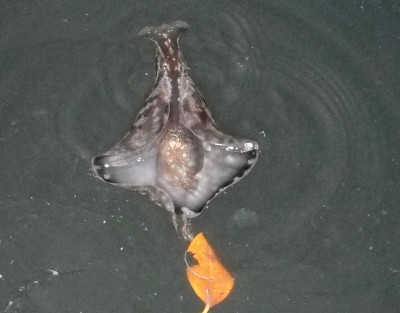
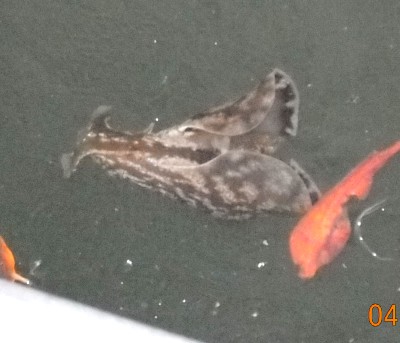
My husband and I saw these interesting little creatures on April 16, 2010, in Estero Bay at Fort Myers Beach, Florida. They varied in length from about 3 inches to 9 inches. A woman scooped one out of the bay in a pitcher and it proceeded to spray pink/purple ink. I thought it was a sea slug because I had, unfortunately, seen them washed up on the beach before, only those were more pink in color, and I had never seen one swim before.
Locality: Estero Island/Bay, Fort Myers Beach, surface, Florida, USA, Gulf of Mexico, 16 April 2010, sandy bottomed no wake zone of Estero Bay at a marina. Length: 3 - 9 inches. Photographer: Carol Geisen.
Is this a "Sea Hare"? Do they all swim?
Thank you for your input. I love your web site.
Carol Geisen
cegeisen@yahoo.com
Geisen, C. E., 2010 (Apr 22) More swimming Sea Hares in Florida. [Message in] Sea Slug Forum. Australian Museum, Sydney. Available from http://www.seaslugforum.net/find/23554Dear Carol,
Yes this is a Sea Hare. It is Aplysia brasiliana. have a look at the Fact Sheet on Sea Hare swimming. Not all species swim. As a general rule of thumb only those in which the parapodial flaps are separate at the back end of the body have enough 'flap' to enable swimming.
Best wishes,
Bill Rudman
Re: Aplysia brasiliana from Florida
April 12, 2010
From: Kelsey Workinger
Concerning message #23453:
I agree that this species was indeed an Aplysia brasiliana. They are really neat to watch swim. I am a marine biology student, and have seen smaller specimens in the Indian River Lagoon in Ft. Pierce, FL. Over the past couple months I have seen 3 of the sea hares at least 1 ft long here in Naples (just north of Marco Island). Luckily I realized what it was, and it was close enough to the dock, I reached down and picked it up for my friends to see. From what I have learned the inking is a pretty common defense mechanism. The one we caught and studied in the IRL was constantly inking, but to my surprise these three, on separate occasions, never inked. Do you think this was just a coincidence or do they not ink as often as I assumed?
Locality: Naples, 3ft-6ft, Florida, Gulf of Mexico, Feb-April, Marinas. Length: 10-12 in
Thanks so much!
Kelsey Workinger
klworkinger6@gmail.com
Dear Kelsey,
If you search for inking using the Forum Search facility you will find a large list of messages and Fact Sheets on the topic. Otherwise go to the Sea Hare Ink Glands Fact Sheet. Sea Hares can only manufacture their purple ink if they have been feeding on red algae, so your 'de-inked' animals may have used up all their ink supply either by a recent inking episode or because they haven't eaten red algae in a while
Best wishes,
Bill Rudman
Re: Aplysia brasiliana from Florida
April 12, 2010
From: Karen Geck
Concerning message #23445:
We just spotted an Aplysia brasiliana off of our dock on the north end of Longboat Key, Florida. It was about 11 inches long. Thanks for the picture on this website.
Locality: Longboat Key, Surface, Florida, USA, Gulf of Mexico, April 11, 2010, On canal. Length: 11 inches
Karen Geck
Karenlgeckklg@aol.com
Geck, K. L., 2010 (Apr 12) Re: Aplysia brasiliana from Florida. [Message in] Sea Slug Forum. Australian Museum, Sydney. Available from http://www.seaslugforum.net/find/23476Re: Aplysia brasiliana from Florida
April 7, 2010
From: Kevin Parker
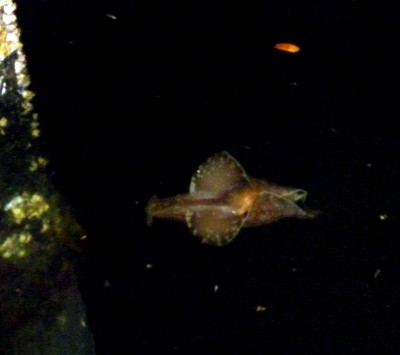
Concerning message #23445:
We saw it too at Marco Island, Florida in the Canals off Hickory Court.
Locality: Canals of Marco Island, Surface to 3 inches deep, Florida, USA, Atlantic Ocean Gulf of Mexico, 4/6/2010, Canal, sandy/rocky mixed bottom. Length: 8 to 10 inches. Photographer: Kevin Parker.
Kevin Parker
kevinmparker@yahoo.com
Parker, K., 2010 (Apr 7) Re: Aplysia brasiliana from Florida. [Message in] Sea Slug Forum. Australian Museum, Sydney. Available from http://www.seaslugforum.net/find/23453Dear Kevin,
Thanks for the feedback. From your photo I can confirm it is Aplysia brasiliana
Best wishes,
Bill Rudman
Aplysia brasiliana from Florida
April 6, 2010
From: Betsy Geis
We saw something in a canal off Marco Island Florida that we've never seen before. I thought at firt it was a turtle or baby stingray. Instead it was what looked to be a beautiful snail without a shell and wings to each side that it floated and swam with. It was shades of brown with patterns with what looked like a head of a big snail and flaps to each side that it used to float itself along the top of the water. It stopped by a wooden dock leg to eat barnicales. What was it?
Locality: Marco Island, Canal 2 feet to 12 feet (tides), Florida, USA, Pacific Gulf, 4/5/10, sea water canal. Length: 8 - 12 inches. Photographer: no photograph available.
Betsy Geis
mbgeis@aol.om
Geis, E., 2010 (Apr 6) Aplysia brasiliana from Florida. [Message in] Sea Slug Forum. Australian Museum, Sydney. Available from http://www.seaslugforum.net/find/23445Dear Betsy,
Without a photo it's a bit hard to be sure but I think you are probably describing a swimming Sea Hare, most probably Aplysia brasiliana. Have a look at message #21742 for some photos of an animal from Texas. For furtehr information look at the species Fact Sheet and earlier messages on this species
Best wishes,
Bill Rudman
Gills of Aplysia brasiliana?
March 5, 2009
From: Linda Ianniello
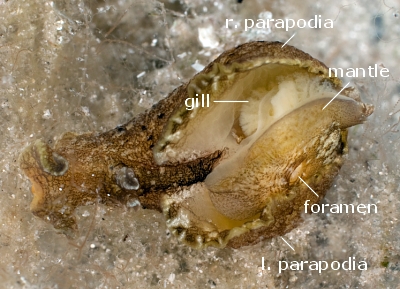
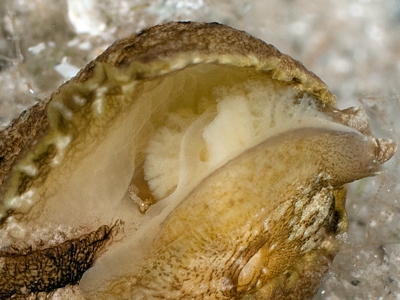
Dr. Bill,
I know there are a lot of images of Aplysia brasiliana on the Forum, but I am wondering whether this image is showing the gills? There are images of them swimming, but none seem to show the gills like this. So I wonder if this one is damaged?
Locality: Lake Worth Lagoon, 10 feet, Florida, USA, Atlantic Ocean, 28 February 2009, Tidal. Length: Approx. 2 inches. Photographer: Linda Ianniello.
Thanks and best regards,
Linda I.
lindai1@bellsouth.net
Ianniello, L.M., 2009 (Mar 5) Gills of Aplysia brasiliana?. [Message in] Sea Slug Forum. Australian Museum, Sydney. Available from http://www.seaslugforum.net/find/22311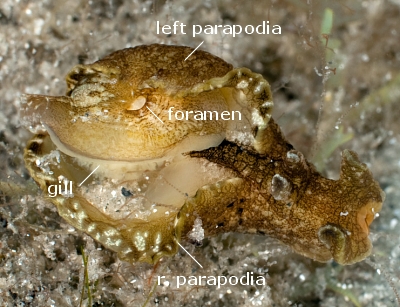
Thanks Linda,
I thought the best way to answer this was to add some labels to your photos and refer you to the Sea Hare mantle cavity page. There is clearly some damage but I can't see just what has happened. The animal should not ne holding its shell and mantle up so high so all I can presume is that something has taken a bite in their somewhere. The hole I have labelled the foramen is in most aplysiids a tiny opening into the internal shell cavity. For it to be so open as this suggest the animal is quite sick. Only a few species, such as Aplysia parvula have a wide mantle foramen such as this.
Best wishes,
Bill Rudman
Re: Aplysia brasiliana and swimming
February 9, 2009
From: Villand Bergerhoff
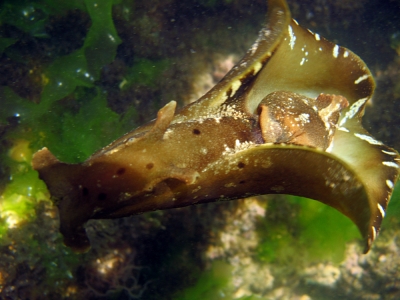
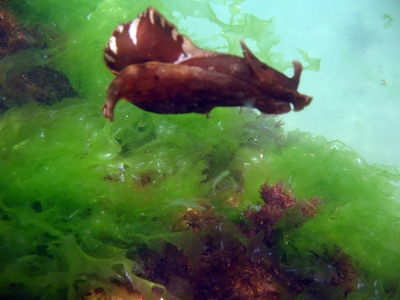
Concerning message #1310:
Hi Bill.
I am writing from Bahia, Brazil. Here are some pictures of Aplysia brasiliana that I saw swimming.
I read the post from Vinicius about the Aplysia fasciata Vs. Aplysia brasiliana [message #19409 ]. For me, we have the two species, because the black Aplysia can not swim. I have found the black Aplysia in Bahia, and this never swimm.
PS: I have an video with A. brasiliana swimming
Locality: Lauro de Freitas, 1.5 m, Bahia, Brazil, Atlantic, 14 December 2008. Length: about 27 cm. Photographer: Villand Bergerhoff.
Villand Bergerhoff
viliberger@gmail.com
Bergerhoff, V., 2009 (Feb 9) Re: Aplysia brasiliana and swimming. [Message in] Sea Slug Forum. Australian Museum, Sydney. Available from http://www.seaslugforum.net/find/22224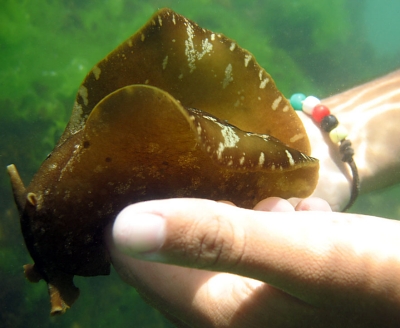
Dear Vili,
Thanks for the photos and your observations. Aplysia fasciata from Europe can also swim, so your black Aplysia is unlikely to be that species.
One possibility is that it is the black form of Aplysia juliana which is another widespread species and does not swim. If you look at the A. juliana Fact Sheet you will see it has an unusual way of crawling along - often forming the back of the foot into a rounded sucker. It also has the back of the parapodia joined into a high wall around the back of the shell and mantle cavity. If you have photos of it I might be able to identify it, but photos of black animals are quite difficult to take and to see any detail in.
Best wishes,
Bill Rudman
Re: Sea Hares on South Padre Island, Texas
July 25, 2008
From: Frances Noe
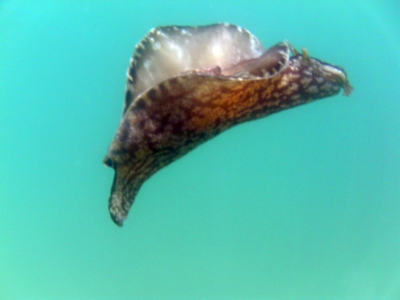
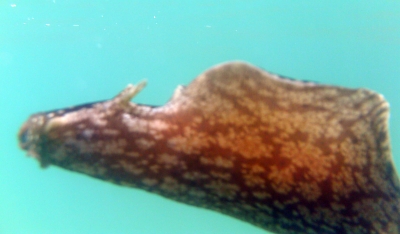
Concerning message #16665:
My son spotted a sea hare swimming about 75 feet from the shore in Isla Blanca Park on South Padre Island. It was swimming in the surf, in about 4 to 5 feet of water. I have tentatively identified it as Aplysia brasiliana, but would appreciate confirmation or correction of this.
Locality: South Padre Island, 4-5 feet, Texas, USA, Gulf of Mexico, 21 July 2008, In surf, approx. 75 feet from shore. Length: 6 inches. Photographer: Frances Noe.
Thanks,
Frances
angel_4856@hotmail.com
Noe, F.K., 2008 (Jul 25) Re: Sea Hares on South Padre Island, Texas. [Message in] Sea Slug Forum. Australian Museum, Sydney. Available from http://www.seaslugforum.net/find/21742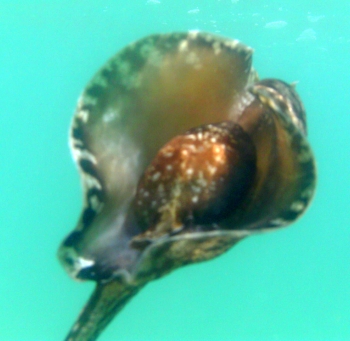
Dear Frances,
Yes this is Aplysia brasiliana, but as I note on the Fact Sheet, this species is probably the same as the European species Aplysia fasciata.
Your lower photo shows the mantle inside the parapodial flaps very well. Have a look at the mantle cavity page for more details.
Best wishes,
Bill Rudman
Sea Hare in Wilmington, North Carolina
July 1, 2008
From: Holly Cunningham
Concerning message #21556:
We found a beautiful greenish/brown Sea Hare in a shallow tidal pool in a channel between the ocean and intercoastal waterway. It was swimming or should I say, gliding quickly through the water. What a great thing for the children to see.
Locality: Intercoastal Waterway/Channel/Tidal Pool/Wilmington, 2 feet, North Carolina, USA, Atlantic Ocean, June 7, 2008, Intertidal. Length: 4 - 5 inches. Photographer: Holly Cunningham.
Holly Cunningham
hsignorello@ec.rr.com
Cunningham, H., 2008 (Jul 1) Sea Hare in Wilmington, North Carolina. [Message in] Sea Slug Forum. Australian Museum, Sydney. Available from http://www.seaslugforum.net/find/21634Re: Spanish Dancer (?) congregation in Florida
December 6, 2007
From: Brian Jackson
Concerning message #21153:
Bill,
Thank You for the reply. I spoke with the proprietor of the Fish shop. He stated he had seen these animals in local waters. I regret not taking more interest at the time & getting a picture. Now I'm even more curious than ever. I hope I can come up with a pic in the future,
Thank's again & Best Regards,
Brian Jackson
jackson.b.w@comcast.com
Jackson, B., 2007 (Dec 6) Re: Spanish Dancer (?) congregation in Florida. [Message in] Sea Slug Forum. Australian Museum, Sydney. Available from http://www.seaslugforum.net/find/21265Re: Spanish Dancer (?) congregation in Florida
November 28, 2007
From: Brian Jackson
Concerning message #7150:
I live near Jacksonville on the North East coast of Florida. I was at a local fish store When a man brought in what we could only guess was a Spanish Dancer. We could not find a good picture close to this specimen. The Man was trying to sell it & wouldn't divulge where he had collected it. He also stated there where a lot in the area. what threw us was we couldn't find any reference of them living in our local waters. Well I just found this site & the reference to a Hexabranchus morsomus. I have never seen one here. I have no idea if it is a rare to find them in numbers this far north. We do have a higher number of warm water fish due to very mild winters the past several years. I don't have a picture, It was mottled dark red with whitish spots .
Locality: Jacksonville, tidal I assume, Florida, USA, Atlantic ocean, November 5th 2007, North EAst coast of Florida. Length: about the size of a beercan top. Sorry not up on the Metric system!
Anyway, I was pleased I found this site & wanted to say Thanks.
Best Regards,
Brian Jackson.
jackson.b.w@comcast.net
Jackson, B., 2007 (Nov 28) Re: Spanish Dancer (?) congregation in Florida. [Message in] Sea Slug Forum. Australian Museum, Sydney. Available from http://www.seaslugforum.net/find/21153Dear Brian,
Thanks for your interest. The name Spanish Dancer usually refers to the tropical Indo-West Pacific species Hexabranchus sanguineus and was given to it because of its resemblance, when swimming, to the swirling dress of a Spanish Flamenco dancer [see message #17274]. I would be surprised if the local H. morsomus could ever be found in numbers which could be described as swarming, but we still have a lot to learn about these animals.
Without a photo however it is a bit hard to be sure what you had. I am pretty sure the animals in the earlier message you referred to [#7150] were sea hares, but again, without an illustration its hard to know,
Best wishes,
Bill Rudman
Re: Aplysia extraordinaria from nthn New Zealand
June 16, 2007
From: Jackie Coles
Concerning message #19642:
Hello
Thank you for having this site
I've been looking at this creature for a month. I never knew we had such creatures in our waters, they are beautiful.
Locality: Honey Moon beach, Florida, 6 inchs, florida, gulf of mexico, may 26 2007, low tide. Length: 14 to 16 inches. Photographer: no picture.
Thanks again
Jackie
jqlbne@yahoo.com
Coles, J., 2007 (Jun 16) Re: Aplysia extraordinaria from nthn New Zealand. [Message in] Sea Slug Forum. Australian Museum, Sydney. Available from http://www.seaslugforum.net/find/20039Dear Jackie,
Glad you like the site. If your animal is in Florida then it won't Aplysia extraordinaria which is found in Australia and New Zealand, but is most probably Aplysia brasiliana which is a swimming species found along the shores of the west Atlantic, and may in fact be the same as Aplysia fasciata from the east Atlantic. If you go to the Sea Hares Fact Sheet you will find links to a lot of information on these fascinating animals.
Best wishes,
Bill Rudman
Re: Aplysia brasiliana & A. cervina
February 23, 2007
From: Vinicius Padula
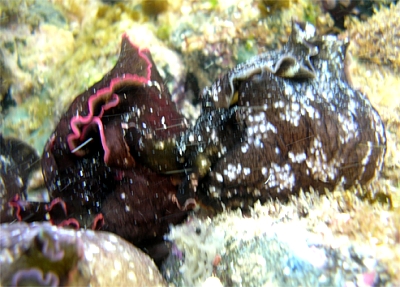
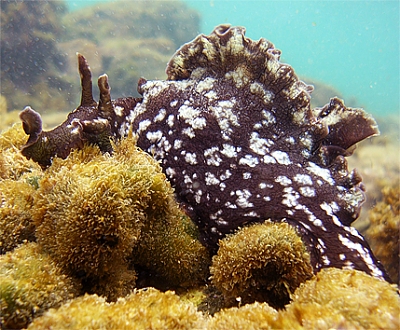
Concerning message #19409:
Dear Bill,
These are some pictures from Rio de Janeiro, Brazil, of color variation in intertidal specimens of Aplysia brasiliana.
As you can see, animals with and without red parapodial border occur together. A lot of specimens, with considerable variation, can be found this month in Rio de Janeiro.
Medina et al.(2005), based on DNA sequence analysis, suggested that A. brasiliana and A. fasciata are synonyms, and that A. cervina is very closely related, if not the same.
-
Medina, M., Collins, T., Walsh, P.J. (2005) Phylogeny of Sea Hares in the Aplysia Clade Based on Mitochondrial DNA Sequence Data. Bulletin of Marine Science, 76 (3): 691-698.
Best wishes,
Vinicius Padula
viniciuspadula@yahoo.com
Padula, V., 2007 (Feb 23) Re: Aplysia brasiliana & A. cervina. [Message in] Sea Slug Forum. Australian Museum, Sydney. Available from http://www.seaslugforum.net/find/19511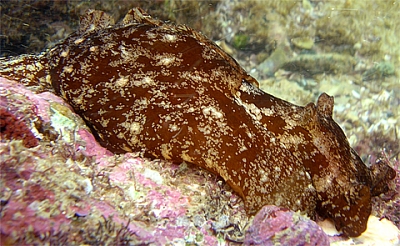
Dear Vinicius,
As I discussed earlier [#12545], your previous photos certainly indicated that A. brasiliana and A. fasciata were almost certainly the same species. I'm surprised I missed this paper but very glad that you have drawn my attention to it. I will have to find some way to merge the large lists of messages on the Forum for these two species.
Best wishes,
Bill Rudman
Aplysia brasiliana & A. cervina
February 9, 2007
From: Carlos Meirelles
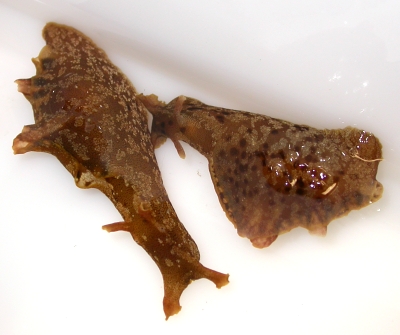
Concerning message #19358:
Dear Bill,
We believe these animals are Aplysia brasiliana. These two forms are pretty common here and usually mate in lab tanks.I don't know if the spotted form has been seen in other places but I think the pattern of the spots are similar to tha pattern on A. cervina.
Locality: Beach, 10 cm, Ceara, Brazil, Atlantic Ocean, 02 February 2007, Intertidal Zone. Length: 90 mm. Photographer: Carlos Meirelles.
Regards
Carlos
cameirelles@gmail.com
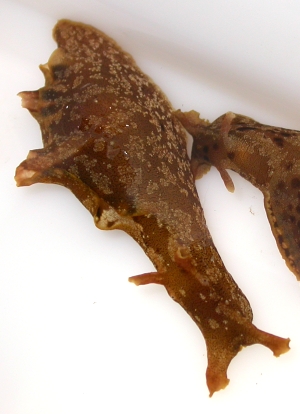
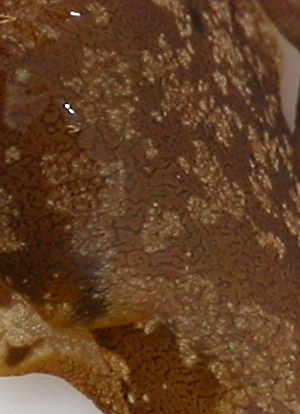
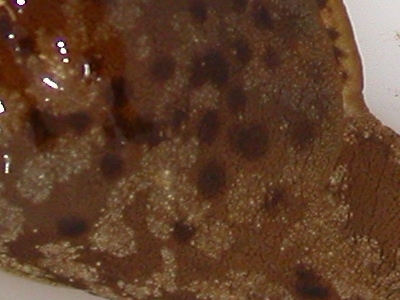
Dear Carlos,
Thanks for the quick reponse. I would agree that the spotted animal here is the same as the earlier one which I, on the basis of the Marcus's publication, identified as A. cervina. I have been unable to find any recent publications on A. cervina, but these photos certainly support the conclusions of Sara Black which I mentioned in your earlier message. So I think you should consider your spotted animal to be A. brasiliana.
If it is still alive, why don't you introduce it to a nice unspotted A. brasiliana and see if they recognise each other?
Best wishes,
Bill Rudman
Re: Aplysia cervina from Brazil
February 1, 2007
From: Carlos Meirelles
Concerning message #19350:
Dear Bill,
We´re keeping this specimen in a tank and it really swims. Most of the time it is crawling on the substrate but if disturbed, it begins swimming all over the tank.
Carlos Meirelles
cameirelles@gmail.com
Meirelles, C., 2007 (Feb 1) Re: Aplysia cervina from Brazil. [Message in] Sea Slug Forum. Australian Museum, Sydney. Available from http://www.seaslugforum.net/find/19358Note added 9 Feb 2007: see message #19409 showing this is a colour form of Aplysia brasiliana.
Thanks Carlos,
Certainly sounds as though it is a swimmer. Are you familiar with Aplysia brasiliana? It is always possible that A. cervina is a spotted form of that species. The anatomical differences are not great, and since we know so little about A. cervina it is possible it is just a colour form of this common species. I note that there are quite a few published papers on aspects of the physiology and DNA of A. cervina, but since its identity seems so problematic, I wonder how these researchers have been identifying their animals? While looking for some photos on the web I found an abstract outlining research by Sara Black at Texas A&M University, Galveston where she reported anatomical, DNA evidence and reproductive behaviour suggesting A. brasiliana, A. cervina and A. fasciata are all the same species. I certainly suggested A. brasiliana and A. fasciata were probably the same [message #12545], so it would be interesting to see what Sara discovered. I am trying to contact her to see if her results are to published.
One possibility would be for you to introduce a specimen of typical A. brasiliana into the aquarium with A. cervina and see if they will mate. It would also be useful way to compare their external shape and movement to see if there are any obvious differences, such as parapodial size, shape of rhinophores and oral tentacles, length of 'tail' etc. If you have two living animals together it should be quite easy to see major differences in shape and proportion.
Best wishes,
Bill Rudman
Aplysia cervina from Brazil
January 31, 2007
From: Carlos Meirelles
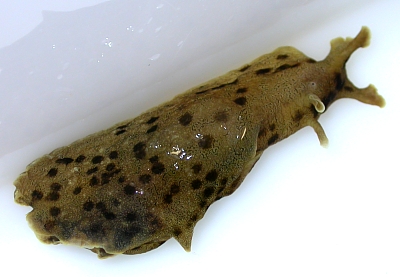
Dear Dr. Bill,
We´re having many doubts about the ID of this Aplysia. It was collected in a estuarine area, dying in a exposed sand bank during the low tide. We observed that this animal doesn't release the purple ink. It feeds on Ulva and flaps its wing-like 'parapodia' to swim. Could it be an A. juliana?
Locality: Estuary , Ceará State, Northeast Brazil, Atlantic Ocean, 25 January 2007, sand bank during the low tide. Length: 60 mm. Photographer: Carlos Meirelles.
Regards
Carlos
cameirelles@gmail.com
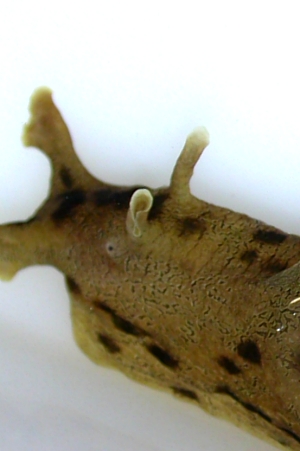
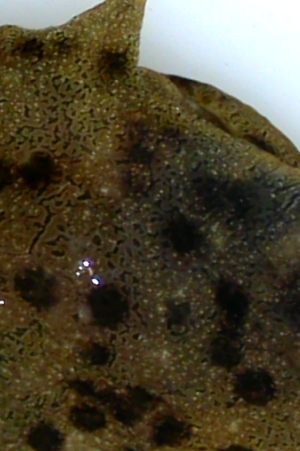
Note added 9 Feb 2007: see message #19409 showing this is a colour form of Aplysia brasiliana.
Dear Carlos,
I think this is a very interesting find. Although A. juliana doesn't produce red/purple ink there are a number of reasons why I don't think this is that species. The most important is that the parapodia join posteriorly, quite high above the body whereas in your animal they don't join and in fact join the body posteriorly very low down. Also I have never seen a A. juliana with spots like this. I am pretty sure you animal is Aplysia cervina, which can have numerous dark brown spots on each side, as in your animal. At present we don't have this species on the Forum, and I can't recall having seen a photo of the living animal before. There is a chance that A. cervina is a colour form of A.brasiliana but in Eales' major revision of species (1960) she considers them different and mentions that in A, cervina the rhinophores have a deep slit almost to the base, which can be seen in your photo. In A. brasiliana the rhinophores are quite small and the slit goes about halfway.
This raises your observation that the animal didn't produce purple ink, although A. cervina has a purple gland. Sea Hares need to feed on red algae to produce their characteristic red/purple ink. They can be effectively 'de-inked' if fed a diet of green algae. So perhaps your animal had been washed ashore, far from its normal habitat, and had only green algae [Ulva] to feed on.
Another mystery is why this species seems to be so rare, most reports being of single specimens. The Marcuses, who despite years of collecting around Sao Paulo, only ever found a single specimen, discuss its rarity (1957) but they have no ideas on why it is rarely found. You mention that it 'flaps its wing-like 'parapodia' to swim'. Do you mean you saw it swimming or do you mean it flaps its parapodia as though it was trying to swim? The reason I ask is that I can find no reference to A. cervina swiming.
-
Eales, N. B. (1960) Revision of the world species of Aplysia (Gastropoda, Opisthobranchia). Bulletin of the British Museum (Natural History), Zoology, 5(10): 267-404.
-
Marcus, E. and Marcus, E. (1957) Notes on Aplysia. Boletim do Instituto Oceanografico, 8: 3-22.
Best wishes,
Bill Rudman
Aplysia willcoxi - a junior synonym of A. brasiliana?
December 22, 2006
From: Anthony Fernando
Hello Dr. Rudman,
I'm working on a list and key of North Carolina opisthobranchs and I'm a little confused about the validity of the species Aplysia willcoxi Heilprin 1886 (or 1887).
Malacolog asserts A. willcoxi Heilprin 1887 as valid.
The NODC taxonomic code index asserts A. brasiliana as a senior synonym.
Marcus and Marcus accepted A. willcoxi as valid, but list it as Heliprin, 1886. They apparently never had a specimen. Eveline Marcus keyed A. brasiliana from A. willcoxi and A. winneba on the basis of only the tip of the caecum being visible on the surface of the digestive gland.
And Dr. McDonald's bibliography only lists two publications by Heilprin, one in 1888 and one in 1889. I have the 1888 reference, and it only lists an Aplysia aequorea, and the description does not match Dover's description for A. willcoxi. (The Marcus's didn't describe it in either paper)
Do you know if A. willcoxi is indeed valid, and where the description for it is?
-
Dover, C. V. and Kirby-Smith, W. W. (1979) Field Guide to Common Marine Invertebrates of Beaufort, N. C. Part 1: Gastropoda, Bivalvia, Amphipoda, Decapoda, & Echinodermata. Beaufort: Duke University Marine Laboratory.
-
Heilprin, A. (1888). Contributions to the natural history of the Bermuda Islands Proceedings of the Academy of Natural Sciences of Philadelphia, 1888: 302-328, pls. 14-16.
-
ITIS Report (1996) Aplysia willcoxi Heilprin, 1886. Retrieved from http://www.itis.gov/servlet/SingleRpt/SingleRpt?search_topic=TSN&search_value= 78030 on 12 December 2006.
-
Marcus, Er. (1961) Opisthobranchia from North Carolina. Journal of the Elisha Mitchell Scientific Society, 77(2): 141-151
-
Marcus, Ev. (1977) On the Anaspidea of the warm waters of the western Atlantic. Bull. Mar. Sci., 22: 841-847
-
Rosenberg, G. 2005. Malacolog 4.0: A database of Western Atlantic marine Mollusca. [WWW database (version 4.1.0)] URL http://data.acnatsci.org/wasp
Thank you,
Tony Fernando
anthonyfernando@yahoo.com
Fernando, A.V., 2006 (Dec 22) Aplysia willcoxi - a junior synonym of A. brasiliana?. [Message in] Sea Slug Forum. Australian Museum, Sydney. Available from http://www.seaslugforum.net/find/19011Dear Tony,
Firstly I find many lists of names on the web to be traps for the uninitiated - especially those that seem to have no author or authors listed as responsible compilers of the list. It is very easy to assemble a list of names, throw it into a database program and churn out a list of names in various forms. The web lists you mention don't fall into that category but many you no doubt have found are like that. Rosenberg's list is a list of 'available' names - it is not necessarily a list of valid species. The distinction is important because some names were not correctly introduced under the International Rules of Zoological Nomenclature. We call these 'unavailable' and they can be ignored. If a name is available we then need to consider whether it is a 'good' or 'valid' species or whether the species it refers to already has a name. I note the ITIS site states A. willcoxi is 'invalid' which is confusing. It may be a synonym but it is certainly an available name. They cite Turgeon et al (1998) as the source of the synonymy, but as I have not seen that publication I don't know if the proposed synonymy is base on research or just based on one of the authors' 'gut feelings'.
I am afraid the sea hares worldwide are in need of considerable revision. The only major revision (Eales, 1960) recognised approx 36 species, and a number have been described since then. Her revision was based on literature reports and preserved specimens and I suspect at least a third of those species are unnecessary, but until species are studied on the basis of large scale populations we are not going to sort them out, considering the variability in colour of most species. The species of the west Atlantic are a good example, and need to be considered at least with the east Atlantic species. For example, I have argued a case on the Forum for considering the common west Atlantic Aplysia brasiliana to be a synonym of the east Atlantic A. fasciata. Aplysia winneba, from the west coast of Africa, is certainly a synonym of A. fasciata. Although Eales treats A. willcoxi as a distinct species, I can see nothing in the various descriptions to distinguish it from A. brasiliana. Aplysia willcoxi and A. brasiliana are both large, variably coloured species, which swim. I suspect the test is to find a resident expert who can convincingly show you the differences between these two species and the dark brown Aplysia morio. To further confuse the issue, some west Atlantic species have a worldwide distribution.
The Heilprin paper you are looking for is not listed in Gary McDonald's bibliography because it lists only nudibranch papers, not other opisthobranchs, so Heilprin's papers which include sea hares and nudibranchs are in the bibliography, but the one you were after did not include nudibranchs. The paper has a printed date of 1886, but sometimes the printed date on a paper is misleading because the paper may not have been actually published, or distributed, until the following year. Gary Rosenberg is fairly diligent with dates so I suspect if he has 1887, then this may be one of those cases.
In brief, my advice would be to treat A. willcoxi as a synonym of A. brasiliana but include a footnote in your key explaining that the jury is still out on the west coast aplysiids.
-
Heilprin, A. (1886) A new species of Aplysia. Proc acad nat sci Philadelphia, 3: 364
-
Eales, N.B. (1960) Revision of the world species of Aplysia (Gastropoda, Opisthobranchia). Bulletin of the British Museum (Natural History). Zoology, 5(10): 1-404 [350-2]
-
Turgeon, D. D., J. F. Quinn, Jr., A. E. Bogan, E. V. Coan, F. G. Hochberg, W. G. Lyons, et al. (1998). Common and scientific names of aquatic invertebrates from the United States and Canada: Mollusks, 2nd ed. American Fisheries Society Special Publication 26. 526.
Best wishes,
Bill Rudman
Items from inside Aplysia brasiliana
June 28, 2006
From: Jo O'Keefe
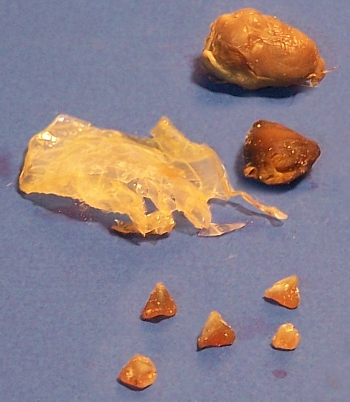
I dissected my dead Aplysia brasiliana [see message #16980 ] and found six items that are almost crystal clear that seem like gems. One went down my kitchen disposal. I want to know what they are. Because I had not dissected anything in 44 years, I caused hairline fractures in the shell while pulling off tissue.
Locality: Sunset Beach, 0.0, North Carolina, USA, Atlantic Ocean, 06 June 2006, intertidal. Length: 9.0 inches. Photographer: Jo O'Keefe.
Thank you.
Jo O'Keefe
jo@okeefes.org
O'Keefe, J., 2006 (Jun 28) Items from inside Aplysia brasiliana. [Message in] Sea Slug Forum. Australian Museum, Sydney. Available from http://www.seaslugforum.net/find/16995Dear Jo,
Have a look at the Sea Hare gizzard Fact Sheet where you will see a drawing of the strange horny plates found in the gizzard of Sea hares. I have used this 200 year old woodcut from a famous French biologist, George Cuvier, to illustrate this anatomical feature, because it is wonderful to know that even with minimal equipment and the aftermath of the French revolution, there were, even then, mad people studying sea slugs.
In your photo, the light brown [centre left] object is part of the shell, while the other objects - or at least most of them - are the large bulky gizzars plates which form a band of crushing plates to pulverise the sea weed before it enters the sea hare's stomach.
Best wishes,
Bill Rudman
Sea Hare from southern North Carolina
June 28, 2006
From: Jo O'Keefe
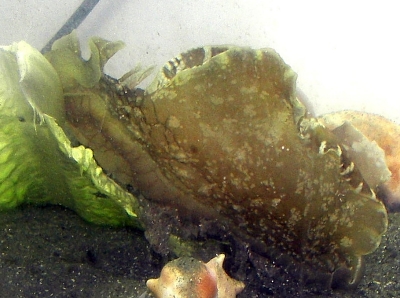
I am writing to you the beached sea hares that I found recently. It is apparent from your messages that they are being found along the coast of both North and South Carolina, USA. I have written to two women who wrote to you. I had not seen them in 12 years. I learned that recently a scientist won a Nobel prize for his work on their neurons because they are both large and few. I saved the juvenile green one in my salt water aquarium and fed it romaine lettuce until it died. I am eager to dissect it to try to find its fragile shell. Although I will again attach photos, they can be seen on my website under Marine Life, Other Sea Life. My website is www.okeefes.org.
My animal is probably Aplysia brasiliana.
Locality: Sunset Beach, beached; on sand, North Carolina, USA, Atlantic Ocean, 01 June 2006 through 06 June 2006, Intertidal. Length: 5 ins. to 9 ins.. Photographer: Jo O'Keefe.
Jo O'Keefe
jo@okeefes.org
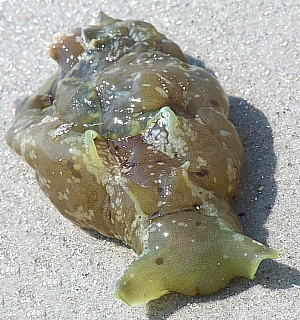
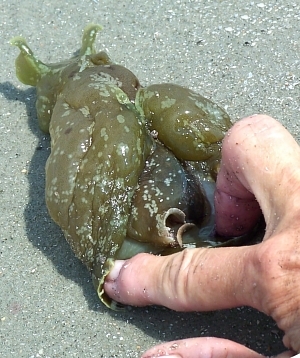
Dear Jo,
I don't think Sea Hares do their best on garden lettuce, but some people have had success with it by 'blanching' it first - quickly dipping it in and out of boiling water.
If you go to the General Topics List on the menu list at top left of every page you will find a section on Sea Hares which should give you a lot of information on these fascinating animals. I see you have already found information by looking at earlier messages on this species.
Best wishes,
Bill Rudman
Re: Pink Sea Hare from Florida
June 23, 2006
From: Heather Clark
Concerning message #16882:
Bill,
Thank you for the reply to my question. This is a wonderful website, very informative and well put together.Since, placing the seahare in my aquarium, it seems to have vanished. In reply to someone else's question, you stated it most likely buried itself. Hopefully that is the case in my situation as well.
Again, thank you for your time and knowledge.
Sincerely,
Heather Clark
Hutchinson Island, Florida
jamesmatula@aol.com
Clark, H., 2006 (Jun 23) Re: Pink Sea Hare from Florida. [Message in] Sea Slug Forum. Australian Museum, Sydney. Available from http://www.seaslugforum.net/find/16950Sea Hare from Charleston, S. Carolina
June 23, 2006
From: Hannah Nelson-Horne.
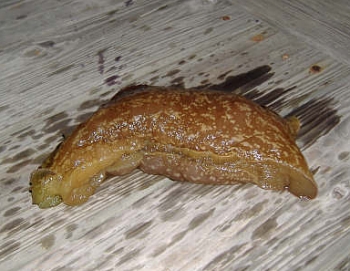
My family and I spotted this Sea Hare (Aplysia ) while in Charleston, South Carolina. A marine biologist (Dr. Dennis Allen) at the Baruch Marine Field Laboratory helped us identify it as such. I wanted to send these photos in, just in case you wanted to use them for research or for curious folks like us to peek at :)
Locality: Isle Of Palms, near Charleson, Skimming Top of water, SC, USA, Wild Dunes Marina, 10 June 2006, Muddy, 4 feet of water, dredged for marina. Length: 10 inches?. Photographer: Hannah Nelson-Horne.
Dr. Allen said there has been an unusual large number of these animals seen on/around our local waters. Any reason why?
Thanks so much!
Hannah Nelson-Horne.
mhannahnelson@hotmail.com
Nelson-Horne, H.., 2006 (Jun 23) Sea Hare from Charleston, S. Carolina. [Message in] Sea Slug Forum. Australian Museum, Sydney. Available from http://www.seaslugforum.net/find/16951Dear Hannah,
This is Aplysia brasiliana. If you go to the General Topics index and have a look at the Sea Hares list, you will find a lot of general information on these fascinating animals. In particular, have a look at the Mass Mortality pages where unusual population explosions are discussed. I don't know if you have already done so, but the other messages on this species are also worth looking at for more discussion.
Best wishes,
Bill Rudman
Pink Sea Hare from Florida
June 21, 2006
From: Heather Clark
Yesterday, after a particularly heavy rainstorm, I went to the beach. There were many types of vegetation on the shoreline washed up. I found several small snails, clams, sponges, even an anenome. What I found next, seemed to be a slug, still crawling even though it was completely out of the water. I took it home and placed it in my aquarium. This thing was absolutely beautiful, very pale pink with small white spots, with "wings" that extended the length of it's body. It looks like a butterfly or an angel(if you will) swimming through the water.
After looking through all of the pictures you have here, the one it most closely resembles is the Aplysia sagamiana?
Locality: Hutchinson Island, on shore, Florida, USA, Atlantic, 14 June 2006. Length: @ 2 inches
Heather Clark
jamesmatula@aol.com
Clark, H., 2006 (Jun 21) Pink Sea Hare from Florida. [Message in] Sea Slug Forum. Australian Museum, Sydney. Available from http://www.seaslugforum.net/find/16882Dear Heather,
At first I wondered whether you had found a large Gastropteron chacmol, but 2 inches would be too large for that species, so as you suggest, the most likely candidate is a species of Aplysia. However Aplysia sagamiana is a Pacific species so I suspect your animal is a juvenile, probably of Aplysia brasiliana. Juveniles often have a more colourful appearance than adults.
Best wishes,
Bill Rudman
Sea Hare from Sth Carolina, USA
June 16, 2006
From: Natalie Barbare
Can anyone help in identifying a sea slug I found beached in a tidal pool in South Carolina, US? When I put it back in the water, its body was a cream color with no particular markings, but its "wings" were distinctive. It swam by undulating the "wings" attached to its sides and the wings were red wine colored irregular spots. It did not crawl on the sand, but stayed swimming for several minutes as I walked by it in the shallow water.
Locality: Sandy beach, beached in tidal pool, South Carolina, USA, Atlantic Ocean, 06 June 2006, sandy tidal pool. Length: 9 inches.
Thanks for any ideas!
Natalie Barbare
natalie202@hotmail.com
Barbare, N., 2006 (Jun 16) Sea Hare from Sth Carolina, USA. [Message in] Sea Slug Forum. Australian Museum, Sydney. Available from http://www.seaslugforum.net/find/16872Dear Natalie,
From your description I would say you have found a large Sea Hare. The most likely species would be Aplysia brasiliana. Have a look at the Fact Sheets and earlier messages for more information.
Best wishes,
Bill Rudman
Sea Hare from South Carolina
June 8, 2006
From: Kassandra Humphrey
Hi,
This past week I was in Isle of Palms, South Carolina in the United States. While my friends and I were walking along the beach we came upon what looked like a sea slug washing up in the surf! We jokingly called it a sea slug because we had never seen one. After looking up information I am sure that it was a sea slug, I just don't know what kind of species slug it was, or if there are more prevalent species in the Carolina area that might help to narrow down my search.
Locality: Isle of Palms, Surf , South Carolina, United States, Atlantic Ocean, 02 June 2006, intertidal. Length: between 7 and 9 inches
It was between 7 and 9 inches and was spotted maroonish burgundy. With a skirt like bottom. It was still alive so I tried to place it back in the ocean. After I walked away a deep pinkish purple color flooded the water. We didnt know if it was blood or some kind of poison.
Does anyone have any information regarding this sea slug?
Thanks!
Kassandra Humphrey
kokonut27@aol.com
Humphrey, K.M., 2006 (Jun 8) Sea Hare from South Carolina. [Message in] Sea Slug Forum. Australian Museum, Sydney. Available from http://www.seaslugforum.net/find/16791Dear Kassie,
It sounds as though you found a Sea Hare. The purplish ink you describe is only produced by that group of sea slugs. Have a look at the Fact Sheets for more information. The most likely species in your part of the world is Aplysia brasiliana.
Best wishes,
Bill Rudman
Sea Hares on South Padre Island, Texas
May 26, 2006
From: Ulli Schoenknecht
Hello,
I would like to thank everyone here in the Forum for providing all this great information! We found several sea hares (Aplysia brasiliana, as I found out here today) on the beach of South Padre Island this morning. It was obvious that they were still alive and so we brought them back into the water. I was worried if it was harmless to touch them or not, but I am glad I found here in the forum that there's nothing to worry about. They are fascinating creatures!
Locality: South Padre Island, on the shore, Texas,USA, Gulf of Mexico. Length: ca. 30 cm
Thanks again,
Ulli Schoenknecht
ullischoen@yahoo.com
Schoenknecht, U., 2006 (May 26) Sea Hares on South Padre Island, Texas. [Message in] Sea Slug Forum. Australian Museum, Sydney. Available from http://www.seaslugforum.net/find/16665Dear Ulli,
Glad to help,
Bill Rudman
Re: Sea hare in Alabama
May 10, 2006
From: Keith Ammons
Concerning message #16547:
Thank you for the posting and the information.
Keith
tourof12@aol.com
Ammons, K., 2006 (May 10) Re: Sea hare in Alabama. [Message in] Sea Slug Forum. Australian Museum, Sydney. Available from http://www.seaslugforum.net/find/16555Sea hare in Alabama
May 8, 2006
From: Keith Ammons
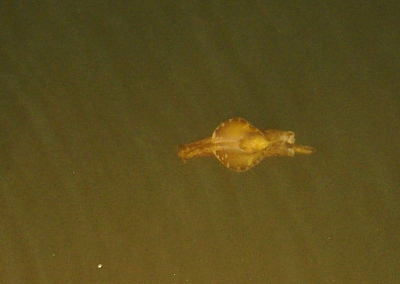
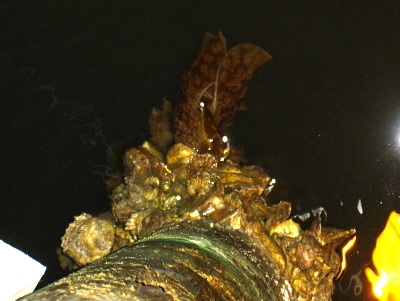
A few nights ago, around midnight, at dead tide I observed a Sea Hare Aplysia brasiliana swimming in the dock lights of our pier. The posts are covered with oysters and it looked as if the Sea Hare was feeding on the shells. I have been night fishing this area for almost 20 years and this was my first sighting of the creature. I did not know what it was until I discovered this Forum. Thanks for the extensive references. My question is, are there any populations numbers for the Gulf of Mexico? How common are these animals?
Locality: Orange Beach, 10 feet, Alabama, USA, Old River, , 04, May 2006, Aobut 50 yards south of the orange beach pass. Sandy bottom. Length: 10 to 12 inches . Photographer: Keith Ammons.
Thanks in advance
Keith Ammons
tourof12@aol.com
Ammons, K., 2006 (May 8) Sea hare in Alabama. [Message in] Sea Slug Forum. Australian Museum, Sydney. Available from http://www.seaslugforum.net/find/16547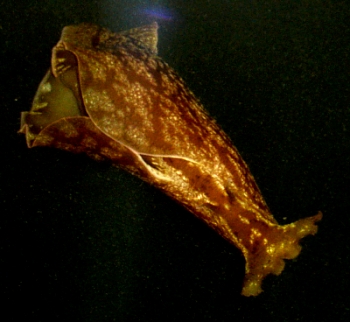
Dear Keith,
Your reaction 'I've been coming here for years and never seen them before' is quite a common response on seeing large Sea Hares. If you look through the messages concerning the different species of Sea Hares on the Forum you will see that people from the Mediteranean, Portugal, Australia and Florida have all responded the same way. I think there are at least two reasons why they are seldom noticed at a particular spot. The first is that humans tend to be creatures of habit and so come to a particular spot, such as a specific jetty each time, while Sea Hares, although they may be in an area regularly, and in large numbers, they may be in a different spot each time perhaps a hundred meters, perhaps a kilometer away from where they were last time. The other reason is that these 'events' are very short lived. You may find a group swimming for a couple of days, or a large aggregation may be there and then gone in a week. I guess you have looked at the Mass Mortality Fact Sheet where I discuss some of the possible reasons for these population fluctuations.
I don't know of any population surveys of Sea Hares in the Gulf of Mexico. I suspect such a survey would be very difficult as they are often hard to see when they are small and when they are large and most obvious they often are at the end of their life cycle and about to die. There distribution can aslo be very patchy. As to how common they are - in many species every individual has the potential to produce tens of thousands of planktonic larvae. After that it is all a bit of a lottery as the larvae have to feed in the plankton, avoid being eaten by plankton-eating predators and then find the right sort of place to settle down and grow to adulthood. Some larvae succeed but obviously most fail. The success rate surely differs from year to year so there will be good years and bad, but the messages coming to the Forum suggest that there are healthy populations of A. brasiliana and A. morio in the Gulf of Mexico.
Concerning you comment of them feeding on oyster shells. They could well be eating sea weeds growing on the shells, or they could just be tired. Although some species can swim for quite a long time, they are normally bottom dwellers, so I guess if they come across a 'rest stop' they make use of it.
Best wishes,
Bill Rudman
Re: Aplysia brasiliana and burrowing
April 13, 2006
From: Gustav Paulay
Concerning message #3946:
Hi Bill - I just came across this message while looking up Aplysia brasiliana. I saw a healthy looking animal actively burrowing into intertidal sand at Ft. Pierce last week. It was methodically pumping down, undergoing muscular peristalsis and periodically ejecting water from its mantle cavity with force. Little question as to this being a deliberate behavior. It was moving vertically down, and reached about 5 cm deep by the time I saw it. The animal was out of water, so it may be a behavior to deal with being stranded by the tides.
Locality: Ft. Pierce, 0m, Florida, USA, Atlantic, 31 March 2006, intertidal sand. Length: ca. 15 cm.
Cheers,
Gustav
paulay@flmnh.ufl.edu
Paulay, G., 2006 (Apr 13) Re: Aplysia brasiliana and burrowing. [Message in] Sea Slug Forum. Australian Museum, Sydney. Available from http://www.seaslugforum.net/find/16295Dear Gustav,
Thanks for letting us know. There have been a couple of aquarium observations since that first message [#4220,# 14255] and I found a couple of papers on burrowing in this species [message #4210] so my first thought that it was probably accidental were way off mark. Certainly interesting to hear how it does it.
Best wishes,
Bill Rudman
Sea Slug in the Intercoastal, Texas
March 28, 2006
From: Amy Peterson
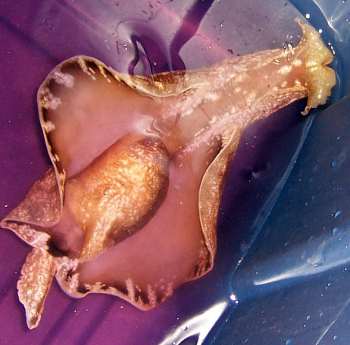
Hi,
We found this creature swimming in the canal at night around our fish light. We live on Padre Island, TX and our canal connects directly to the intercoastal waterway which leads to the Gulf of Mexico. It shot out some pink dye - you can see it in the photo. We'd like to know what it is. Thanks, Amy Peterson
Locality: Padre Island, 9 ft, TX, Gulf of Mexico, 2/23/2006, canal. Length: 12 inches. Photographer: Amy Peterson.
apeterson@stx.rr.com
Peterson, A.L., 2006 (Mar 28) Sea Slug in the Intercoastal, Texas. [Message in] Sea Slug Forum. Australian Museum, Sydney. Available from http://www.seaslugforum.net/find/16172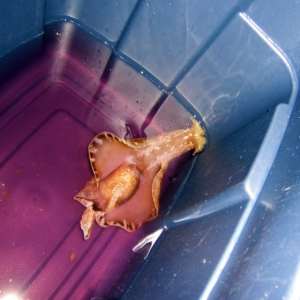
Dear Amy,
When I see the 'Intercoastal' mentioned I can be pretty sure that the question is going to be about a Sea Hare. This is Aplysia brasiliana, a common swimming sea hare in your part of the world. If you look at the other messages attached below your message, you will see photos of other encounters with this strange animal. If you are interested in background information on Sea Hares go to the General Topics index [top left of page], where among other things you will information on their purple or reddish 'ink'.
Best wishes,
Bill Rudman
Research reveals identity of alien creature
March 13, 2006
From: Juliet Jimenez
Concerning message #16074:
Since asking for help in identifying a strange looking creature in the Gulf of Mexico, I have done a bit of research and think I've discovered that it is an Aplysia brasiliana. Found a great video clip of one at hooge.developmentalbiology.com/aplysia, and it looks very familiar.
My kids and I love your website!
Thanks,
Juliet Jimenez
juliet1426@sbcglobal.net
Jimenez, J., 2006 (Mar 13) Research reveals identity of alien creature. [Message in] Sea Slug Forum. Australian Museum, Sydney. Available from http://www.seaslugforum.net/find/16098Dear Juliet,
My answer was in the pipeline before I read this. Yes your research was correct. Thanks for the link to the movie clip of a swimming animal.
Glad you all like the site
Best wishes,
Bill Rudman
Need help identifying this alien creature!
March 13, 2006
From: Juliet Jimenez
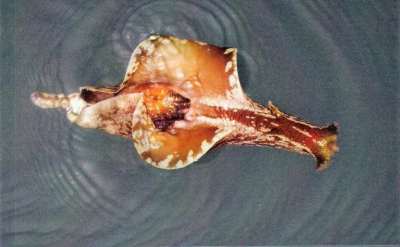
This odd sea animal was spotted at South Padre Island in the Gulf of Mexico last weekend. It was swimming around a boat dock, mainly on the surface, but sometimes venturing deeper into the water. It was very large, over a foot long, and gracefully flapping it's "wings" as it moved slowly about. Friends who've lived in the area for years have never seen anything like it before, and suggested waiting to see if the mothership would come back for it! It looks like some sort of sea slug to me. Please help...everyone is anxious to find out what the heck this thing is.
Locality: South Padre Island, Texas, Surface, Texas, USA, Gulf of Mexico, 04 March 2006, Boat dock, tidal waters on gulf. Length: 12 to 18 inches. Photographer: Gilbert Jimenez.
Thanks,
Juliet Jimenez
juliet1426@sbcglobal.net
Jimenez, J., 2006 (Mar 13) Need help identifying this alien creature!. [Message in] Sea Slug Forum. Australian Museum, Sydney. Available from http://www.seaslugforum.net/find/16074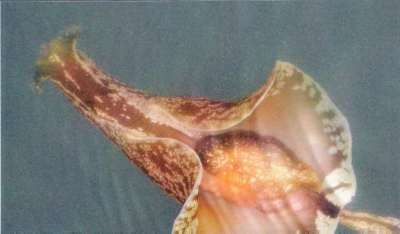
Dear Juliet,
This is a Sea Hare, and almost certainly Aplysia brasiliana, the common brown swimming sea hare in your part of the world. If you look at the other messages attached below your message, you will see you are not the first peopel to think it is a very weird animal when swimming. If you are interested in background information on Sea Hares go to the General Topics index.
Best wishes,
Bill Rudman
Re: Swimming Aplysia fasciata from Spain
March 4, 2006
From: Adrienne Zedella
Concerning message #8449:
We saw this creature swimming and coming up for air off the coast of Florida in April 2005. we didn't want to touch it (didn't know what it was or if it was poisonous). It was taking loud breaths and we assumed it was in distress, but we didn't know what to do about it, not having a net. it was fascinating and i am further intrigued wondering what it was doing in a foreign area. it was also very close to shore in about 2 feet of water, then swam along the shore further north out of our view. we do not know what became of it but was a valuable experience for myself and my 2 youngboys.
Locality: Singer island , 1 1/2 ft - 2 ft water, Florida, USA, Atlantic coast, April 2005, close to shore. Length: about 12 - 15" head to tail (?).
Adrienne Zedella
chichijunk@cs.com
Zedella, A., 2006 (Mar 4) Re: Swimming Aplysia fasciata from Spain. [Message in] Sea Slug Forum. Australian Museum, Sydney. Available from http://www.seaslugforum.net/find/16001Dear Adrienne,
The animal you saw was almost certainly a sea hare, most probably Aplysia brasiliana. If you look at the Fact Sheet for that species you will find quite a few earlier messages reporting it from Florida. It's interesting you should think the Spanish animal was the same as yours, as there is some pretty convincing evidence to show that one of the large swimming sea hares on the European side of the Atlantic, Aplysia fasciata, is the same as the common American species A. brasiliana [see message #12545].
If you look up Sea Hares on the General Topics list [top left of this page] you will find a lot of pages with background information on these animals.
Best wishes,
Bill Rudman
Re: Burrowing Sea Hares
August 19, 2005
From: Joey Lau
Concerning message #4220. Mine was hidden for almost a week, I was worried that it was dead. Suddenly I saw him+her "stuck" in a hole in the rocks; since I thought he+she was dead, I took him+her out. As I did so, he+she began moving around. Three minutes later, he+she began to burrow into the substrate. Within 2 minutes, he+she was out of sight. The substrate is only 2 inches deep, so I don't know how deep would he+she burrow if given the chance.
Joey Lau
damntv@gmail.com
Lau, Joey K.-Y., 2005 (Aug 19) Re: Burrowing Sea Hares. [Message in] Sea Slug Forum. Australian Museum, Sydney. Available from http://www.seaslugforum.net/find/14255Dear Joey,
Nice to know that some discussions on the Forum never die!
Best wishes,
Bill Rudman
Sea Slug in Pompano Beach, Florida
March 4, 2005
From: Sandy Kerr
In Pompano Beach, Florida, USA we found a dark brown liver colored sea slug. The marine services people told us that it was a rare sea slug. We are just trying to figure out the scientific name for this creature. It was about 12 inches long.
Sandy Kerr
Approvedmortgages@yahoo.com
Kerr, S., 2005 (Mar 4) Sea Slug in Pompano Beach, Florida. [Message in] Sea Slug Forum. Australian Museum, Sydney. Available from http://www.seaslugforum.net/find/13275Dear Sandy,
It's very difficult to help without a description or a photo. Its possibly a Sea Hare. If so it could be Aplysia morio or Aplysia brasiliana which are common Caribbean species. In fact the photo of Aplysia morio on the Fact Sheet is from Pompano Beach
Best wishes
Bill
Sea Hare? from Florida
February 15, 2005
From: Millicent Parker
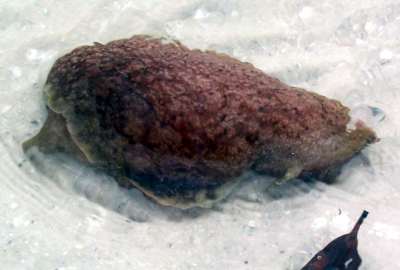
Found this washed up on Marco Island, Tigertail Beach. Returned it to water and it emitted large quantity of purple colored fluid.
Locality: Tigertail Beach, Marco Island, Florida, USA, Gulf of Mexico.
Depth: On beach, low tide. Length: 10 inches. 7 February 2005. Intertidal
Photographer: Millicent Parker
Please see picture,
Thanks.
Millicent Parker
mparker573@yahoo.com
Parker, M., 2005 (Feb 15) Sea Hare? from Florida. [Message in] Sea Slug Forum. Australian Museum, Sydney. Available from http://www.seaslugforum.net/find/13144Dear Millicent,
From your photo it is definitely a Sea Hare, and it is almost certainly Aplysia brasiliana. Have a look at the Fact Sheet and accompanying messages from more information on the species. See also the Purple Ink Page.
Best wishes,
Bill Rudman
Nudibranch from Galveston Bay , Texas
February 11, 2005
From: Damian Menning
I had heard about a seasonal nudibranch that lives in the Galveston Bay area of Texas, Gulf of Mexico. Apparently they have been found during the fall near oyster beds. I would like to do a life history project on them but can't seem to find any information regarding them. Do you have any ideas as to what they are or could be? I know it's not the nudibranch found on Sargassum.
Thanks for the help.
Damian
fireknut73@hotmail.com
Menning, D., 2005 (Feb 11) Nudibranch from Galveston Bay , Texas. [Message in] Sea Slug Forum. Australian Museum, Sydney. Available from http://www.seaslugforum.net/find/13125Dear Damian,
You don't give us many clues. Two things come to mind. One is Elysia chlorotica, which often lives in large populations which all die together after about 10 months. The other is a couple of Sea Hares, Aplysia brasiliana and Aplysia morio. Click on the names and you'll find photos and information on these three species in the messages attached to each Fact Sheet. However I am a long way from Texas, so perhaps someone closer will have some other ideas on what you are looking for.
Best wishes,
Bill Rudman
Aplysia brasiliana swimming
March 17, 2004
From: Richard Shanahan
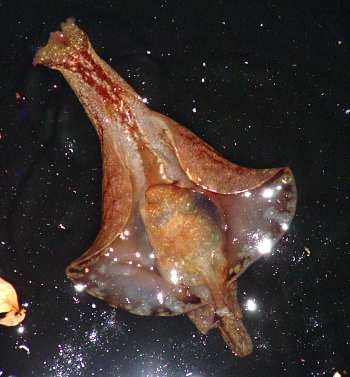
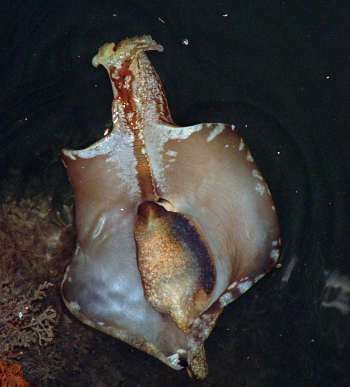
Dear Bill,
Thanks for your comments [#12434].
They where there 3 nights in a row and I now have better photos. I was also told that these guys are called 'Spotted Sea
Hare also known as a 'Ink Fish'.
Richard Shanahan
r.j.shanahan@prodigy.net
Shanahan, R.J., 2004 (Mar 17) Aplysia brasiliana swimming. [Message in] Sea Slug Forum. Australian Museum, Sydney. Available from http://www.seaslugforum.net/find/12469Thanks Richard,
Often their size makes them difficult to photograph so it's nice to get a couple more photos of them swimming. I have heard cuttlefish called 'ink fish' in Italy because their ink is used to taste and colour such dishes as Risotto nero alle seppie - black risotto with cuttlefish
I haven't heard 'Ink Fish' being used before for Sea Hares. I guess it refers to the red or purple ink they sometimes squirt out.
Best wishes
Bill Rudman
Swimming Sea Hare in Florida
March 16, 2004
From: Richard Shanahan
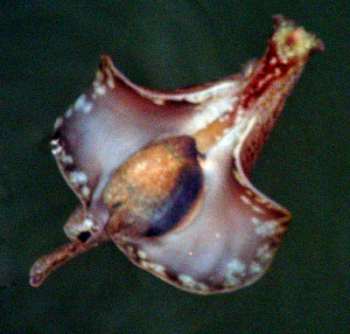
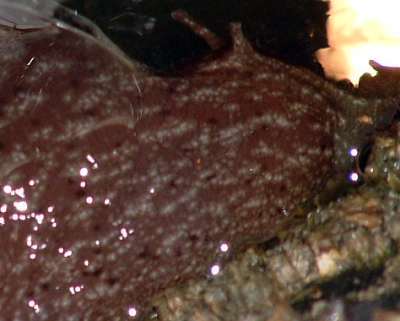
I have 3 photos that I would like to send you of a 10 to 12 inch sea slug I noticed that you did not have any that where this big or looked like this. 2 of them have been at my dock for the last 2 days.
Photo: Marco Island Dock 34145. [Southwest Florida, USA]
Richard
R.J.Shanahan@prodigy.net
Shanahan, R.J., 2004 (Mar 16) Swimming Sea Hare in Florida. [Message in] Sea Slug Forum. Australian Museum, Sydney. Available from http://www.seaslugforum.net/find/12434Dear Richard,
This is a swimming Sea Hare. I guess the "Marco Island" you mention is the one in Florida, USA. If so, this animal is almost certainly a species called Aplysia brasiliana which is one of the common swimming species found in Florida. Have a look at some of the other messages on this page showing animals from Florida. Another species you may find is a dark brown animal Aplysia morio.
Best wishes
Bill Rudman
Swimming Sea Hare from Florida
January 22, 2004
From: Allen Peterson
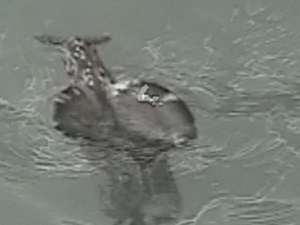
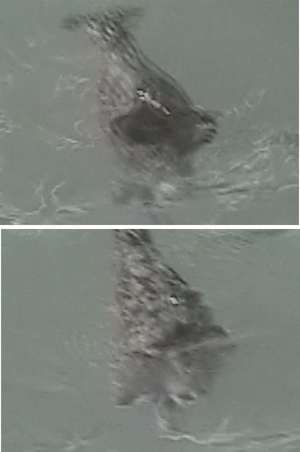
The attached pictures are part of a video sequence that I took at my brother-in-law's in May of 2000. He lives on the Intercostal Waterway, Treasure Island, St. Petersburg, Florida. The video was taken during the incoming tide (about 18 inches), and the critter was trapped in the tidal backwater along the sea wall. It finally broke free and swam away. The attached pictures show the locomotion sequence.
I had never seen this type of creature before. I was told it was a sea cucumber. But something made me question that. I found your site trying to find what kind of critter this is.
I actually have a clean 51 seconds of .AVI file with four different sequences:
- struggling in a bed of seaweed
- trapped on the seawall
- closeup swimming on surface
- somewhat further away, swimming just below surface.
I do my video computer work using Adobe Premier 5.1, which gives me full editing ability, although it is not the newest version. Video quailty is quite good. I presume I am correct in stating this IS a Sea Hare. If not, please correct me. Also, If the swimming sequences are of any use on the internet I would be happy to donate them. Let me know if you are interested.
Al Peterson
alpeterson@attbi.com
Peterson, A., 2004 (Jan 22) Swimming Sea Hare from Florida. [Message in] Sea Slug Forum. Australian Museum, Sydney. Available from http://www.seaslugforum.net/find/11754Dear Al,
Your animal is indeed a Sea Hare and is most probably Aplysia brasiliana. Have a look at the species Fact Sheet and the other messages on the Forum about this species for further information.
Concerning the video clip. At this stage I'm afraid funds don't allow me to include video footage of sufficient quality on the Forum but I am always hopeful that technology or some benefactor will make that possible in the future. So I would welcome a copy of your video clip. I can't promise to use it but if in the future I am able to include some video footage it will mean I have some available. It would be best sent to me in digital format on CD to:
Dr Bill Rudman
The Australian Museum
6 College St,
Sydney, NSW 2010
Australia
Thanks
Bill Rudman
Aplysia brasiliana from Texas, Gulf of Mexico
July 18, 2003
From: Eric Carpenter
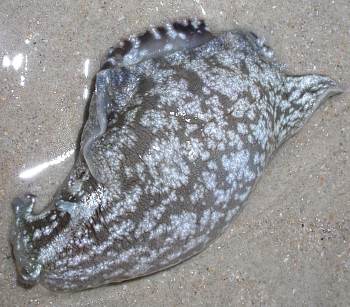
Greetings,
Please find attached 2 images of some type of sea slug (?) that I ran into on the evening of 12 July 2003 at Padre Island National Seashore, Texas, USA (Gulf of Mexico). I am curious if you could help me with the correct identification of it.
This creature was found "swimming" in a shallow pool that had been formed along the beach by the coming-and-going of the tides.
Eric Carpenter
Austin, Texas, USA
ecarpe@aol.com
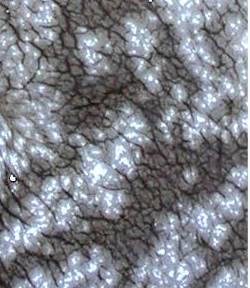
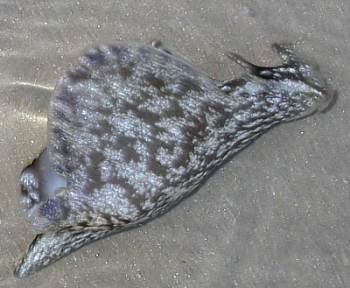
Dear Eric,
This is a Sea Hare. Sea Hares are a herbivorous group of sea slugs, with species found all around the world. Your animal is almost certainly Aplysia brasiliana. Have a look at the species Fact Sheet and the other messages on this page to see other records of them washing up on beaches in large numbers and their swimming behaviour.
Best wishes,
Bill Rudman
Aplysia from Florida
May 29, 2003
From: Hollie Greer
Hi there.
I am a wildlife ecology major in Florida, USA, but I don't have much knowledge of marine life. Recently I went to the beach in Melbourne (just south of Cape Canaveral) and saw several what I believe to be sea slugs. Most were hanging out on rocks at low tide but I also spotted a few swimming in shallow waters. I have reviewed the pictures on your site and the closest I can find is the Aplysia fasciata. The tentacles however were different- they had a more defined shape to them - more "bulbous". Is this species common in Florida waters? Are they typically found this close to shore or was there a reproductive or other reason they were in that location?
Thanks for the info. Your website is great, Hollie
holbgol@yahoo.com
Greer, H., 2003 (May 29) Aplysia from Florida. [Message in] Sea Slug Forum. Australian Museum, Sydney. Available from http://www.seaslugforum.net/find/9973Dear Hollie,
In your part of the world the most likely swimming Sea Hares you are likely to find are Aplysia brasiliana and Aplysia morio. Have a look at the messages on those pages for more information, and discussion about the way sea hares sometimes tend to aggregate in large groups.
Best wishes,
Bill Rudman
Baby Aplysia brasiliana swimming
April 18, 2003
From: Anne DuPont
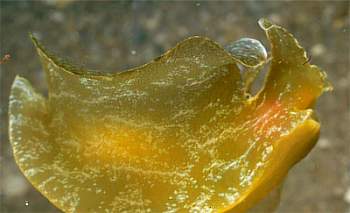
Dear Bill,
Thought you would like to see a photo of a "baby" swimming Aplysia brasiliana.
On Saturday night (April 5, 2002) we were doing a night dive up in West Palm Beach. (Florida, USA). I was in about 10 feet of water and this little golden yellow slug came swimming by. It was about 1 1/2 inch long, and was very actively swimming, so much that it was almost impossible to take a photo). It was swimming about midway in the water column. I sent it to Dr. Thomas H. Carefoot, University of British Columbia, and this is his response:
"It is, indeed, an Aplysia ... A. brasiliana to be precise. This is the species that we studied last year in Texas and will study again this year (in May). We were wondering at what age (size) it would swim, so now we know that it does so at about 4cm length." - (Dr. Thomas H. Carefoot, Department of Zoology, University of British Columbia. Vancouver, Canada).
Best regards,
Anne
akdupont@bellsouth.net
DuPont, A. , 2003 (Apr 18) Baby Aplysia brasiliana swimming. [Message in] Sea Slug Forum. Australian Museum, Sydney. Available from http://www.seaslugforum.net/find/9713Thanks Anne,
Bill Rudman
Sea Hare - Ft Myers Beach, Florida
February 25, 2003
From: Cindy Volk
Was walking along the shore, saw an unidentified sea creature. Couple stopped and identified it as a sea slug. It unfortunately was dying...it looked liked a slimy blob with pink under it. Could you tell me more about this particular type found in the Gulf of Mexico.
Thanks.
Cindy Volk
volkcindy@aol.com
Dear Cindy,
Your animal is almost certainly a Sea Hare. There are a number of species which live and wash up dying along the Gulf of Mexico. Have a look at the pages on Aplysia morrio and Aplysia brasiliana. There are quite a few messages on the subject there and links to photos of the purple/red ink many species produce when they are disturbed or 'sick'.
Best wishes,
Bill Rudman
Sea hares everywhere, Coastal Alabama
September 4, 2002
From: Becky Roland
I am a graduate student at the University of South Alabama. Every year we conduct an annual beach survey to measure sand movement. This year while conducting our surveys I noticed many sea hare bodies laying all over the beach and in the swash zone soon to be deposited on the beach(August 13th and 14th).
I have seen sea hares in Panama City, FL at Saint Andrews State park; however, I have never encountered them while swimming along Alabama's coast. Can someone tell me if they are usually found here and why they would be washing onto the shore? I think I saw two different species. The larger ones were a deep reddish/purple color and the smaller ones had a light brown color with darker spots.
Thanks,
Becky
rolanrm@hotmail.com
Roland, R., 2002 (Sep 4) Sea hares everywhere, Coastal Alabama. [Message in] Sea Slug Forum. Australian Museum, Sydney. Available from http://www.seaslugforum.net/find/7801Dear Becky,
If you have a look at the pages on Aplysia morio and Aplysia brasiliana you will see many reports of these 2 species occurring at times in large swarms in Florida. Your descriptions suggests you probably have the same 2 species doing the same thing in Alabama.
Best wishes,
Bill Rudman
Hundreds of slugs in Florida
June 20, 2002
From: Trevin Bernarding
I spent last week on LongBoat Key, Florida, on vacation with my family. On our first day at the beach, June 9, we encountered literally hundreds of sea slugs on the beach, on the water bottom, and floating in the surf. I have gone to LongBoat off and on for the last 20 years and have never encountered even one of these creatures, let alone hundreds. The sea slugs looked like large brown shell-less snails, and would emit a purple liquid as a defense mechanism. By the end of our stay six days later, the slugs were mostly gone. My children and I are quite curious as why such an enormous population would suddenly appear on the beach, and we are equally curious as to why they would disappear a mere few days later.
Trevin Bernarding
trevinb@hotmail.com
Bernarding, T., 2002 (Jun 20) Hundreds of slugs in Florida. [Message in] Sea Slug Forum. Australian Museum, Sydney. Available from http://www.seaslugforum.net/find/7310Dear Trevin,
'Swarming' slugs emitting purple ink can only mean Sea Hares. Have a look at the Sea Hares page for some general information and links to other pages. The two species you are most likely to find doing this in Florida are Aplysia brasiliana and Aplysia morio. If you look at both those pages, and their attached messages, you will find photos and information about both species in Florida and their 'swarming' behaviour. Concerning why such large populations can apparently appear and disappear so quickly, have look at the Mass Mortality page.
best wishes,
Bill Rudman
Thanks for info
June 17, 2002
From: Bruce de Haas
Dear Dr Rudman
Thanks you for identifying the Sea Hare from the Gambia. It does look a lot like Aplysia brasiliana. It is a gracious and beautiful creature. The mating chains are fascinating behaviour. The sea is so amazing, you never know what you will discover next! Thanks for the Sea Slug Forum it is exceptionally well put together and very interesting.
Regards
Bruce de Haas.
brucedehaas@yahoo.com
de Haas, B., 2002 (Jun 17) Thanks for info. [Message in] Sea Slug Forum. Australian Museum, Sydney. Available from http://www.seaslugforum.net/find/7276Swimming slug photos from W. Africa
June 1, 2002
From: Bruce de Haas
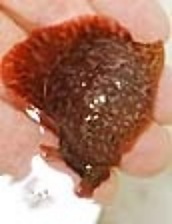
Dear Dr Rudman
In my last mail to the forum I described a swimming slug I noticed in the Gambia river estuary. I have now managed to capture and photograph one of these slugs. This specimen is much smaller than the two I saw before. It also appears to be lighter in coloration. Please can you give any insight as to what species it may be? Can you tell me anything about it or related species.
The first two photos are dorsal views and the last is a lateral view (the foot of the slug being on the right hand side). When the
slug is not swimming it tends to contract its self so that it appears shorter.
Thank you for your help.
Sincerely
Bruce de Haas
brucedehaas@yahoo.com
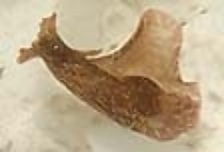
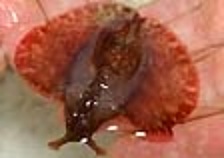
Dear Bruce,
As they say 'a picture is worth more than a 1000 words'. This is a Sea Hare. If you go to the Sea Hares page you will find links, messages and more information about these animals. Quite a few species swim like this, including two species well known in the western Atlantic from Florida to Brazil - Aplysia brasiliana and Aplysia morio. One of these species, A. brasiliana, has been recorded from West Africa and if you look at the photos and messages on the Forum concerning that species you will see it looks very like your photos.
Another possibility is Aplysia fasciata which is found on Atlantic coast of Europe and the Mediterranean. It has also been recorded from West Africa. It is usually black or very dark brown but can have whitish blotches. It is also a swimmer.
Best wishes,
Bill Rudman
Sea snail or slug? from Florida
May 22, 2002
From: Mary Bigari
Hello,
i am new at this salt water thing and i was recently cleaning out the sea strainers on the boat and i found many interesting and weird animals in there but the one that caught my eye was about the size of a quarter. one of the guys i know told me it was a sea snail but i think it is a sea slug and i think it got bigger. i live in fort pierce florida and we often travel to miami and ft. lauderdale. this "slug" or whatever it was was the size of a quarter when closed but then when it swam it opened up and it had "wings" it was a brownish color and when i put it in a cup a few minutes later its slime on the side of the cup turned purple. i let it go in the waters here and a few weeks later i saw the same thing except a lot bigger. about the size of a saucer. if you could be any help id appreciate it. i dont think they bite or are toxic but id like to know for sure and any other info you may have. thank you for your time.
Mary Bigari,
United States Coast Guard
mbigari@yahoo.com
Bigari, M., 2002 (May 22) Sea snail or slug? from Florida. [Message in] Sea Slug Forum. Australian Museum, Sydney. Available from http://www.seaslugforum.net/find/7006Dear Mary,
Your mystery animal is a Sea Hare and the species you found is almost certainly Aplysia brasiliana. If you have a look at those two pages, click on anything underlined, and look at attached earlier messages you will find a wealth of information on these animals.
Is it a snail or a slug"? Have a look at Dana Farnsworth's recent message where I discuss that very question. Producing purple ink purple ink is a characteristic of most aplysiids. We don't know its function.
Best wishes,
Bill Rudman
Sea Hare Question
May 15, 2002
From: Dana Keith Farnsworth
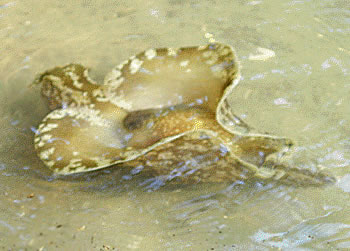
Hello!
Being a diver who is more than very interested in identifying fish and sea creatures, I was blown away when this thing swam by the shore at my camp site while I was at Canaveral national Seashore in Florida. I have never seen one before, and was completely interested in discovering what it was. I guessed that it was a giant snail that somehow was seperated from its shell. Pretty good guess .... Using Paul Humman's Identifying Sea Creatures, I found that it was a Sea Hare. After reviewing your site, I believe he is a Aplysia brasiliana Rang, 1828. However, I'm not sure what the growth like thing on its back is. It was circular and seemed fixed. Can you help? Is it the undeveloped internal shell I've been reading about?
Thanks,
Dana
Dana.Farnsworth@astrazeneca.com
Farnsworth, D. K., 2002 (May 15) Sea Hare Question. [Message in] Sea Slug Forum. Australian Museum, Sydney. Available from http://www.seaslugforum.net/find/6946Dear Dana,
Yes your animal is almost certainly A. brasiliana and the lump on its back is what remains of the shell and mantle cavity its snail ancestors would have had. If you are interested in how snails became slugs have a look at the What is a slug? page. If you are interested in learning more about Sea Hares the Sea Hare page will give you links to a lot of background information including a page showing some shells of Sea Hares and their relatives.
A good photo of the mantle cavity can be seen on the Syphonota geographica page.
Best wishes,
Bill Rudman
Black swimming slug
April 30, 2002
From: Bruce de Haas
I wonder if someone can help me identify a species of slug I observed recently. The sighting took place in Banjul, The Gambia, West Africa. I saw the slug swimming next to the dock in Banjul harbour which is situated in an estuary at the mouth of the Gambia river. The water is salty at this point the bottom is muddy and the visibility usually poor as a result of sediment.
I saw two slugs which were almost entirely black. They were 150 mm long and 40mm wide. Roughly cylindrical in shape. The posterior end was slightly tapered and the anterior end blunt with small protrusions. In the middle of the body on the dorsal surface was a circular sail like appendage with which the snails swam. This was about 120mm in diameter. I saw the snails in the light of bright security lights at night. It was during a spring high tide. There was a great deal of activity in water with fish swimming and jumping close to the surface. The slugs where also swimming at the surface. I have not seen a slug quite like this one before and would be interested on learning more about it.
Thanks you for your kind assistance.
Regards,
Bruce de Haas
brucedehaas@yahoo.com
de Haas, B., 2002 (Apr 30) Black swimming slug. [Message in] Sea Slug Forum. Australian Museum, Sydney. Available from http://www.seaslugforum.net/find/6821Dear Bruce,
I can't think of any black slugs which fit your description. Any reason for thinking it was a slug? More importantly, any reason why it wasn't a small fish - eel, lamprey, hagfish perhaps? Perhaps someone will have some ideas
Cheers,
Bill Rudman
Re: Aplysia - Mass mortality in Florida
January 9, 2002
From: Daren Hoffman
Bill,
I have found a large number of dying sea hares which I believe to be Aplysia brasiliana. They are practically identical to the ones found by Anne Dupont. I was wondering if you could tell me why they start to die off and wash up to shore about this time of year. I live in Florida on an island in the Gulf of Mexico. Last year, at this time, I witnessed the same incident. The bay's shores were littered with either dying or dead sea hares. My hypothesis is that the water has become to cold for them to survive. I don't think it has anything to do with mating or old age because the young and old alike are dying, also I have found numerous sea hare egg sacs washed up on land. I would appreciate it if you could help me out.
Thanks,
Daren Hoffman
silver_palm@yahoo.com
Hoffman, D., 2002 (Jan 9) Re: Aplysia - Mass mortality in Florida. [Message in] Sea Slug Forum. Australian Museum, Sydney. Available from http://www.seaslugforum.net/find/5922Dear Daren,
Mass mortality events often seem to be triggered by an adverse weather event, so I guess cold water could be a factor although Sea Hares seem to survive well in aquaria in much cooler water than they normally experience in the field. Have a look at Mike Schmale's message discussing mass mortality in Aplysia brasiliana. He suggests that adults dying of old age often become much smaller than when they were healthy, so if you are judging small animals to be 'young' on their size, then this may not necessarily be so. Also have a look at the Mass Mortality Page for more information.
Best wishes,
Bill Rudman
Does Aplysia brasiliana have a mating season?
June 28, 2001
From: Ray
Is there any certain time Aplysia brasiliana mate or group up???
I am interested if they had any mating season or if they grouped up for some reason because my friend and I were looking for sea cucumbers and other animals and we saw some Aplysia brasiliana so we decided to go closer inshore and we saw about 13 purplish-brownish colored sea slugs and about 7 tan colored sea slugs. We were on a sandy bottom, 4-5ft. near intercoastal. Is there any difference in the sex of Aplysia brasiliana from its color or are they asexual??
Ray
barracuda9000@aol.com
Ray, 2001 (Jun 28) Does Aplysia brasiliana have a mating season?. [Message in] Sea Slug Forum. Australian Museum, Sydney. Available from http://www.seaslugforum.net/find/4663Dear Ray,
I guess from your mention of the 'intercoastal' you are talking of the Caribbean waters somewhere in the southern USA.
Most Sea Hares are fairly seasonal with egg laying in early spring and sometimes in late summer. But it differs with different species and in different places and there are always some individuals that breed some other time. You often find Sea Hares in large groups because that's how their populations work. A large number of larvae will settle out of the plankton at a certain place and in a few months most of the larvae will have grown to adulthood and be ready to mate at the same time. Sea Hares are hermaphrodite, which means they have fully functional male and female sex organs. Often they mate in pairs, one acting as male, the other as female, but in large groups they can form mating chains.
The reason for the colour difference in the animals you saw is that you probably had two species, the dark one being Aplysia morio and the tan ones Aplysia brasiliana. There is a lot more information on Sea Hares in the Forum. Click on anything underlined or use the navigation buttons at the top and bottom of each page to have a look.
Best wishes,
Bill Rudman
Swimming slugs from North Carolina
June 26, 2001
From: Rhenee Helms
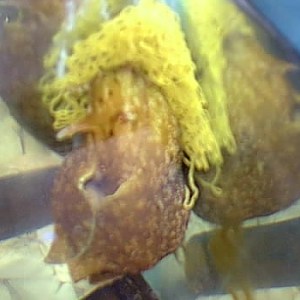
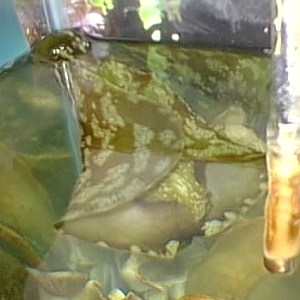
Hey my name is Rhenee Helms I have a salt Water aquarium. Friday I went to visit some friends well one of the guys bring up a rake with a slimy animal on it. I picked it up not knowing what I was looking at it looked like a slug, but it came from the ocean. I went to the boat slip and saw another one swimming around. When it swam it looked like a bat/sting ray with the head of a slug. They quickly got the other one and i took them home and put them into my salt water aquariam. When they are not swimming they are stuck to the side of the tank moving around like a slug. I need to know what kind of animal it is, what to feed it. Also today Sunday the littlest one went into the corner and started laying eggs ... or at least that is what it looks like. I will try to e-mail pictures. I looked all over the site for something that remotely looked like it but i could not find anything .. not even the eggs. I did however feed the big one today it ate particles of some shrimp. They were picked up in a back water inlet near Oak Island, North Carolina [USA]. Any Information would be greatly appreciated.
Thanks,
Rhenee Helms
lbc_girl2001@yahoo.com
Helms, R., 2001 (Jun 26) Swimming slugs from North Carolina. [Message in] Sea Slug Forum. Australian Museum, Sydney. Available from http://www.seaslugforum.net/find/4666Dear Rhenee,
Your animal is a Sea Hare called Aplysia brasiliana and yes the yellow tangle is its egg mass. For more general information on Sea Hares have a look at the Sea Hares page. For more information on Aplysia brasiliana have a look both above and below your message for previous messages and discussions on this swimming West Atlantic Sea Hare. In case you don't realise, you can move around the Forum by clicking on anything underlined or by using the navigation buttons at the top and bottom of each page.
Concerning feeding your Sea Hares, they are herbivores, feeding mainly on red and green algae. If you want to try keeping them alive in your aquarium then be careful with algae in aquariums, as too much can cause problems. Some people have had success with lightly boiled lettuce.
Best wishes,
Bill Rudman
Doubts about Aplysia brasiliana
June 5, 2001
From: Luis Ernesto Arruda
Dear Dr. Rudman,
Could you please help me with a problem? I found a sea hare in Northeast Brazil that I think is Aplysia brasiliana. It is 5cm long. However, this sea hare released an egg mass in the aquarium. So, my doubt is: is it possible that A. brasiliana is sexually mature at such a small size?
I am a university student and have been studying Aplysia for 3 years. I am study the seasonal cycle of A. dactylomela in two beaches of northeastern Brazil, and the relation between purple ink and seaweeds.
Cordially,
Luis Ernesto
luis_ernesto2@yahoo.com.br
Arruda, L.E., 2001 (Jun 5) Doubts about Aplysia brasiliana. [Message in] Sea Slug Forum. Australian Museum, Sydney. Available from http://www.seaslugforum.net/find/4459Dear Luis Ernesto,
I am not sure how big Aplysia brasiliana is before it is mature enough to lay eggs. In other species, animals begin laying eggs at quite a small size. For example Aplysia kurodai is reported to lay eggs from 31g to 131g (Yusa, 1994). Size is also not a very good indication of age. Animals born early in the growing season tend to grow more slowly than animals that settle into a population later in the season. Late arrivals grow to maturity very quickly but are often only half the size of animals which have been in the population for a longer time when they start laying eggs(Gev, et al, 1984).
So basically your animal may be a late settling A. brasiliana. Check out some other identifying features such as does it swim? does it produce purple ink? These are not exclusive characters of A. brasiliana but if it doesn't do one, or both these things, then it is unlikely to be A. brasiliana.
I would be interested to hear of your work on sea hare ink and algae.
• Gev, S., Achituv, Y. & Susswein, A.J. (1984) Seasonal determinants of the life cycle in two species of Aplysia found in shallow waters along the Mediterranean coast of Israel. J. Exp. Mar. Biol. Ecol., 74: 67-83.
• Yusa, Y. (1994) Size-related egg productin in a simultaneous Hermaphrodite, the sea-hare Aplysia kurodai Baba (Mollusca: Opisthobranchia). Publications of the Seto Marine Biological Laboratory 36(4): 249-254.
• Yusa, Y. (1996) The effects of body size on mating features in a field population of the hermaphroditic sea hare Aplysia kurodai Baba, 1937 (Gastropoda: Opisthobranchia). J. Moll. Stud. 62: 381-386.
Best wishes,
Bill Rudman
Re: Burrowing Sea Hares
April 23, 2001
From: Toni Yeomans
Concerning Sea Hares burrowing. I live on the west coast of Florida and today we found an Aplysia brasiliana in a drying tidal pool and brought it home and placed it in our 75 gal. aquarium for observation. It immediately burrowed into the crushed coral substrate. It has remained that way for the last several hours. I love these guys!
Toni Yeomans
ToniYo@aol.com
Yeomans, T., 2001 (Apr 23) Re: Burrowing Sea Hares. [Message in] Sea Slug Forum. Australian Museum, Sydney. Available from http://www.seaslugforum.net/find/4220Thanks Toni,
Looks like they burrow, at least in aquaria.
Best wishes,
Bill Rudman
Burrowing Sea Hares
April 22, 2001
From: Bill Rudman
In a recent message, Melanie reported finding apparently burrowing Aplysia brasiliana and I suggested that the most likely explanation was that they had been partly buried by sand movement in rough weather, as burrowing was not a known behaviour in Sea Hares. Subsequent to that Don Barclay sent us his interesting observations on burrowing in Dolabella.
I have just discovered a couple of papers by Aspey & Blankenship on Aplysia brasiliana which describe burrowing behaviour in aquaria. In their studies only small animals (less than 250g) would burrow, and they would stay buried for as short a period as 1 hour or for as long as several weeks. They would only burrow as deep as their rhinophores, because at all times the rhinophore tips and mantle cavity siphons were visible or flush with surface. The studies were done in Texas and although the authors report seing burrowing Sea Hares in the field, their only observations were on aquarium animals.
Which only goes to show we still have a bit to learn about these animals. Anyone else with burrowing observations?
References:
• Aspey, W.P. & Blankenship, J.E. (1976) Aplysia Behavioural Biology: 1. A Multivariate Analysis of Burrowing in A. brasiliana. Behavioural Biology, 17: 279-299.
• Aspey, W.P. & Blankenship, J.E. (1976) Aplysia Behavioural Biology: 2. Induced Burrowing in Swimming A. brasiliana by Burrowed Conspecifics Behavioural Biology, 17: 301-312.
Best wishes,
Bill Rudman
Sea Slug from the west coast of Florida
April 16, 2001
From: Nancy Kielich
Dear Dr. R.,
We live in Clearwater, Florida, USA on the Gulf of Mexico. There is a creature swimming in the Gulf sometimes called an inkfish, a sea slug, or a spanish dancer. It is brownish with dark spots. As Floridians, tourists ask us about the creature. We were hoping that you may be able to help us out, as my internet search isn't coming up with a satisfactory answer.
Thank you.
Nancy Kielich
kelix@juno.com
Kielich, N., 2001 (Apr 16) Sea Slug from the west coast of Florida. [Message in] Sea Slug Forum. Australian Museum, Sydney. Available from http://www.seaslugforum.net/find/4186Dear Nancy,
I think the animal you are describing is a Sea Hare which are sometimes called Inkfish because many of them squirt out a purplish coloured ink when they are disturbed. Not all species swim, but one that is common in Florida waters and is brownish with dark spots is Aplysia brasiliana.
I am not sure how familiar you are with the Forum, but if you click on any of the underlined words you will be taken to another relevant page. On each page, make sure you scroll down to the bottom because there are many messages attached to each page with more photos and information.
Have a look at the Aplysia brasiliana Page and let me know if it looks like your animal.
Best wishes,
Bill Rudman
Re: Swimming slug in Florida
March 30, 2001
From: Rob Porter
Bill,
Thanks. The swimming slug was definitely Aplysia brasiliana. And you were right about the spiky one I have seen in 1000's, it's Bursatella leachi. Great work on that. You've been extremely helpful, and gotten me really interested in these creatures.
Rob
fishmystic@hotmail.com
Porter, R., 2001 (Mar 30) Re: Swimming slug in Florida. [Message in] Sea Slug Forum. Australian Museum, Sydney. Available from http://www.seaslugforum.net/find/4065Swimming slug? in Florida
March 25, 2001
From: Rob Porter
I observed what I thought was a nudibranch in a lagoon of the Gulf of Mexico/Tampa Bay in St. Petersburg, Florida (Ft Desoto Park) on March 10th. It appeared to have wings that it undulated and moved through the water (not on the bottom) above a sandy turtle grass flat in about two feet of water. The sighting was well after dark (9:30 pm), on an incoming tide. It seemed to be trying to eat or bite everything it came in contact with at the surface of the water, including our fly fishing line.
The next morning we found one (possibly the same one) washed up on the island about 20 yards from where we had seen it the night before. Upon returning it to the water it exuded a great deal purple ink. The animal had a rusty speckled appearance out of the water.
Just curious if it was a nudibranch, and if so, what kind. Also, how rare is this creature? I have been visiting this area since I was child and have only seen nudibranch on the bottom (1000's of them, with spike-like appendages, possibly mating--not sure what they are either), but never anything like this. Thanks for any info you can provided. Neat web-site!
Rob Porter
fishmystic@hotmail.com
Porter, R., 2001 (Mar 25) Swimming slug? in Florida. [Message in] Sea Slug Forum. Australian Museum, Sydney. Available from http://www.seaslugforum.net/find/4035Dear Rob,
You animal was/is a Sea Hare, which are sea slugs, but not nudibranchs. The purple ink is very characteristic. Have a look at the Sea Hares Page for some general information on these animals. There are a couple of swimming species found in Florida, Aplysia brasiliana and Aplysia morio, and if you look at the recent messages on both those pages you will find they have been appearing and dying in large swarms, in Florida in the last couple of months. From your description I would suspect your animal was Aplysia brasiliana. These animal are herbivores, feeding on seaweeds. I suspect the impression you got that it was trying to eat everything was caused by the way they thresh around in a fairly uncontrolled way when they are swimming.
The spiky animal you often see in thousands, is almost certainly another Sea Hare, Bursatella leachi. Have a look at the photos on that page and in some of the attached messages, to check it out.
Best wishes,
Bill Rudman
Aplysia brasiliana from Florida
March 21, 2001
From: Debby
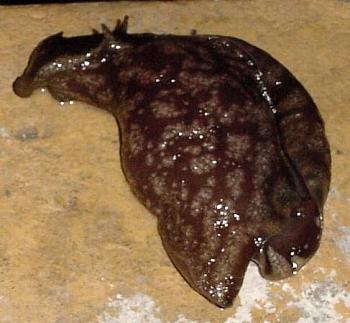
We found this slug like creature hooked to the rocky bank of a canal that runs between Marco Island and Naples Florida, USA. After the picture it was released back into the water. When it was released, it had "fin-like" wings that expanded as it swam away across the top of the water.
The area in which we found this creature was on a very rocky bank in salt water. It was very shallow water, but swam into deeper water when it was released. it floated the entire time without submerging. It was deep brown with black splotches, similiar to a leopard. it weighed about one pound and was about eight inches long. With wings expanded, it was about four inches wide. It had a large set of antenna and a smaller set located behind the first. it also had a large foot on the bottom.
Debby
judge_debby@hotmail.com
Debby, 2001 (Mar 21) Aplysia brasiliana from Florida. [Message in] Sea Slug Forum. Australian Museum, Sydney. Available from http://www.seaslugforum.net/find/4003Dear Debby,
Your animal is a Sea Hare. Have a look at the Sea Hares page for some general information on these animals. Three species, Aplysia brasiliana, Aplysia morio, and Bursatella leachi seem to be quite common in Florida and sometimes occur in very large numbers. If you click on any of the underlined words you will be taken to a page on that topic. Have a look at each of these other pages and you will find messages from other peole who have found these animals in Florida.
I think your animal is a dark colour form of Aplysia brasiliana and Mike Schmale in a separate message has confirmed that for me. Another dark brown swimming species in Florida, A. morio is usually a uniform dark brown without the mottled colour pattern you describe and certainly without the clusters of whitish spots which are visible in your photo.
best wishes,
Bill Rudman
Re: Aplysia brasiliana from Florida
March 21, 2001
From: Mike Schmale
Dear Bill,
Debby's photo is typical of A. brasiliana. We often see them with this coloring. In my experience (very limited with A. morio), A. morio is very dark brown, almost black in color with no distinct patterining on the skin.
All the best,
Mike Schmale
Division of Marine Biology and Fisheries
Rosenstiel School of Marine and Atmospheric Science
University of Miami
Miami, Florida.
mschmale@rsmas.miami.edu
Schmale, M., 2001 (Mar 21) Re: Aplysia brasiliana from Florida. [Message in] Sea Slug Forum. Australian Museum, Sydney. Available from http://www.seaslugforum.net/find/4016Thanks Mike,
Bill Rudman.
Aplysia brasiliana and burrowing
March 13, 2001
From: Melanie
The other day, March 3rd, I was out in a shallow intertidal sand and rock-bottom area of Sarasota Bay, FL. A friend of mine was walking along the intertidal when she noticed purple ink welling up from the sand. We identified it as Aplysia brasiliana, however I had never seen one burrowed quite like this. It had grasped onto some small sized rocks and the parapodia were drawn around its body with only the siphon sticking out of the sediment. Do you know of any other references/literature involving such burrowing behavior? We have had some pretty rough weather the last couple of days with high winds and the bay has become completely churned up.
Cheers,
Melanie
pjtmcape@aol.com
Melanie , 2001 (Mar 13) Aplysia brasiliana and burrowing. [Message in] Sea Slug Forum. Australian Museum, Sydney. Available from http://www.seaslugforum.net/find/3946Dear Melanie,
I suspect the stormy weather you mention is the most probable reason for this 'burrowing'. Rather than burrowing, this sea hare was probably being slowly buried as the rough seas moved the bottom sediments (sand, mud) around. I don't know of any observations of species of Sea Hares burrowing, but perhaps someone else does.
The nearest burrowing relative I can think of is the shelled Akera.
Best wishes,
Bill Rudman
Re: Daughter needs info ....
February 16, 2001
From: Grace Brookshire
Dear Bill,
Thank you so much for the reply and info. I had discovered your site and the photos are fabulous. I would definitely say this was Aplysia brasiliana, which seems to be so common to this area from reading other Forum queries. I haven't read all the letters yet .... but have you answered one giving the basics of how much my child may "interact" with them ... or help the stranded ones? She so wants to "save" them!
Thanks again,
Grace Brookshire
gbmeerkat1@home.com
Brookshire, G., 2001 (Feb 16) Re: Daughter needs info ..... [Message in] Sea Slug Forum. Australian Museum, Sydney. Available from http://www.seaslugforum.net/find/3810Dear Grace,
Glad you could identify your sea slug. Sea Hares are not dangerous to touch, and seem to stand a fair bit of gentle 'petting' 'touching' and 'prodding' by kids. Holding them out of water briefly for a look will cause no problems, but they are sea creatures which will dry out and die if left out of water. You may find they squirt a reddish purple 'ink' when handled.
What do do with stranded ones? There are a number of discussions on the Forum about Sea Hare strandings which are almost always a natural part of the life cycle. See the page on Mass Mortality By all means let your daughter 'save some' by putting them back in the water, but in all probability the Sea Hares have reachd the end of their lifespan and will die soon any way.
Best wishes,
Bill Rudman
Please help......daughter needs info
February 15, 2001
From: Grace Brookshire
We recently moved to the south west coasts of Florida, while eating at a waterside restaurant my daughter went down to the shore to play and noticed several large sea-slugs floating in the water almost up on the shore. We believe there were Hydatina physis (Rose petal) slugs and were quite large, lovely, and docile. There was light near the water and may be way there were several there so close to shore....we> haven't studied them enough yet to know whether this is "normal" behavior. It has been unseasonably cool here this winter and i understand that the manatees and other marine life are coming closer to shores and dying frequently.
My daughter, being 8, and very curious, always wants to "pet" any wildlife she sees....even though i have tried to explain to her that it may hurt them or transmit germs that they are not used to. She really wants to "play" with them....gently if possible.....could be a future marine biologist budding here.
Could you please tell us where to go to find out basic info. about interacting with these lovely sea hares? Any info you might lend would certainly be appreciated...especially by the slugs...i'm sure!
Thank you so much,
Grace Brookshire
Sarasota, Florida, USA
gbmeerkat1@home.com
Brookshire, G., 2001 (Feb 15) Please help......daughter needs info. [Message in] Sea Slug Forum. Australian Museum, Sydney. Available from http://www.seaslugforum.net/find/3809Dear Grace,
If you have a look through the Sea Slug Forum, you may be able to identify the animal yourself. There is a page on Hydatina physis so you'll be able to see if that is that species. [Just click on any underlined word to go to a relevant page] You also mention Sea Hares. Have a look at the General Topics Index where you will find a number of pages of general information on Sea Hares. Two species which are commonly found swimming and stranded in Florida are Aplysia brasiliana and Aplysia dactylomela.
Best wishes,
Bill Rudman
Re: Was it a sea slug?
August 21, 2000
From: Roy Harrell
Thanks,
The animal I saw looks exactly like the ones in Anne Dupont's photos! It's good to know the purple ink wasn't blood and that, since I did put the creature back in the water, it may have survived.
I would like to mention that I also spotted a couple sea turtles hanging out in the same area, which I've never seen before. After reading Michael D. Millers' account of sea turtles dining on Sea Hares, I'm left wondering if there is a correlation in the two sightings.
Roy Harrell
roymh@swbell.net
Harrell, R., 2000 (Aug 21) Re: Was it a sea slug?. [Message in] Sea Slug Forum. Australian Museum, Sydney. Available from http://www.seaslugforum.net/find/2905Dear Roy,
Glad to be of help. Concerning the turtles. It is possible the Sea Hare was swimming because it had been disturbed by the turtles, but some Sea Hares begin swimming without any obvious cause. They are not powerful swimmers, so when they are swimming they are at the mercy of the waves and currents, and are often stranded at lowtide, not because they are trying to escape a predator, but simply because they swim to weakly to avoid stranding in shallow water.
Best wishes,
Bill Rudman.
Was it a sea slug?
August 20, 2000
From: Roy Harrell
Hi.
I was wondering if anyone could help determine what species, if at all, of sea slug this was. I spotted it in Port Aransas, Texas, USA, free-swimming near the surface just off a jetty. It was using 'wings' to propel itself similar to a ray.
The animal was 8" long and 3" wide, a reddish/brown color with white/gray, slightly raised, spots 1/2 inch apart covering its body. Later in the day I found the animal left to die on a rock. It was sill moving, but was bleeding a deep maroon liquid and had begun to dry out.
Roy Harrell
roymh@swbell.net
Harrell, R., 2000 (Aug 20) Was it a sea slug?. [Message in] Sea Slug Forum. Australian Museum, Sydney. Available from http://www.seaslugforum.net/find/2904Dear Roy,
It sounds like you saw a Sea Hare. Have a look at the page on Aplysia brasiliana, which is the species you probably saw, and the messages below yours on this page for reports and photos of this Sea Hare and its swimming behaviour.
The 'purple blood' you saw was not blood but a secretion many Sea Hares produce when they are distressed. Although many publications suggest this purple ink is for defence, we really haven't any evidence to support that idea.
Best wishes,
Bill Rudman.
Florida Sea Slugs
May 3, 2000
From: Sharon
I've seen what people tell me are Sea Slugs around my home in Sarasota, Florida.
They're brown and kinda look like flapping banana peels swimming along. I found one washed up on a sandbar. It was still a little alive so I tried to push it back into the water and it squirted purple ink at me. I didn't even know they did that.
Do you happen to know what species the one I keep seeing is? I'd really like to know.
Sharon
sas21@duke.edu
Sharon, 2000 (May 3) Florida Sea Slugs. [Message in] Sea Slug Forum. Australian Museum, Sydney. Available from http://www.seaslugforum.net/find/2350Dear Sharon,
From the messages and photos the Forum has already received from Florida, I can tell you what your 'flapping brown banana peels' are, even from far away in Australia. If you look at the pictures on this page, above your message, and the earlier messages below yours, you will find that Florida seems to be alive with these swimming sea slugs which are a species of Sea Hare.
Your species is almost certainly Aplysia brasiliana. Have a look at the page on Sea Hares which will give you some general information on Sea Hares, and a list of other pages to look at. If you are new to the Forum be sure to check the messages on each page because they also contain a lot of information.
Best wishes,
Bill Rudman.
Aplysia brasiliana from Brazil
December 17, 1999
From: Carlo Magenta
Dear friends,
Concerning your question about my work on Aplysia brasiliana I couldn't be in touch in the discussions because I had problems with my computer. I'm working with some important specimens saved in a museum. I didn't go out to collect animals, but I'm going to do it too. I will try to find some pictures of the A. brasiliana to send to our Forum. According to my knowledge, there isn't so much variation of the colours. I will send pictures to our Forum as soon as I can..
Best Regards! :)
Carlo Magenta
carlomagenta@uol.com.br
Magenta, C., 1999 (Dec 17) Aplysia brasiliana from Brazil. [Message in] Sea Slug Forum. Australian Museum, Sydney. Available from http://www.seaslugforum.net/find/1676Dear Carlo,
We will look forward to seeing them.
Best wishes,
Bill Rudman.
Re: Aplysia brasiliana mass mortality
November 16, 1999
From: Mike Schmale
[Message forwarded by Anne Dupont]
Dear Ms. DuPont,
The animals in your photos are Aplysia brasiliana, one of the most common species of Aplysia in Florida and the Gulf of Mexico (I believe their range extends to South America). The other very common species here is A. dactylomela.
Sometimes in the winter and spring, especially in windy weather (on-shore winds), lots of dying animals will wash up on the beach. We believe that most Aplysia only live for about one year in the wild and that some of these may represent old, naturally dying animals. Also, these animals
often get smaller when they are near the end of life and so you can not really judge their age by their size in these old animals.
I hope this has been helpful. If you continue to see large numbers of dead Aplysia (or any other marine animal, for that matter), feel free to contact me.
Happy photographing (I'm amateur UW photographer myself),
Mike Schmale
Aplysia Website: http://www.rsmas.miami.edu/groups/sea-hares/
Michael C. Schmale, PhD
Associate Professor
Division of Marine Biology and Fisheries
Rosenstiel School of Marine and Atmospheric Science
University of Miami
4600 Rickenbacker Cswy.
Miami, FL 33149
mschmale@rsmas.miami.edu
Schmale, M., 1999 (Nov 16) Re: Aplysia brasiliana mass mortality. [Message in] Sea Slug Forum. Australian Museum, Sydney. Available from http://www.seaslugforum.net/find/1530Mike Schmale's Aplysia Website at: http://www.rsmas.miami.edu/groups/sea-hares/, which I have referred to before, is well worth a visit.
Bill Rudman.
Identity of Aplysia brasiliana
November 2, 1999
From: Paul Hamilton
The sea hares which Anne Dupont has discussed and provided pictures of from West Florida appear to be Aplysia brasiliana. I have worked on their biology in the Placida/Boca Grande area since 1970, and they swim quite well; in fact I tracked one individual which swam non-stop for about 2 hours while travelling about 1 km. I had some representative specimens identified by Nellie Eales in about 1974, who placed them in the British Museum after identifying them as A. brasiliana. Dr. Eales was the Aplysia taxonomist at the time.
Paul Hamilton
Dept. of Biology
University of Central Arkansas
Conway, AR 72032
paulh@mail.uca.edu
Hamilton, P., 1999 (Nov 2) Identity of Aplysia brasiliana. [Message in] Sea Slug Forum. Australian Museum, Sydney. Available from http://www.seaslugforum.net/find/1467Dear Paul,
Thanks for the message. I am familiar with your interesting papers on celestial navigation and swimming in Aplysia brasiliana. It is good to get a name on Anne's animal. All the indications, suggested that workers in the Caribbean had decided it was Aplysia brasiliana but I could find no literature reference to confirm this - and the original description didn't look very similar.
If you have any information on your research, or on other Caribbean sea hares, it would be very welcome on the Forum.
Best wishes,
Bill Rudman.
References:
• Hamilton, P.V. and H.W. Ambrose III, 1975. Swimming and orientation in Aplysia brasiliana (Mollusca: Gastropoda). Marine Behaviour and Physiology 3: 131-144.
• Hamilton, P.V. and B.J. Russell, 1982. Field experiments on the sense organs and directional cues involved in offshore-oriented swimming by Aplysia brasiliana Rang (Mollusca: Gastropoda). Journal of Experimental Marine Biology and Ecology 56: 123-143.
• Hamilton, P.V. and B.J. Russell, 1982. Celestial orientation by surface swimming Aplysia brasiliana Rang (Mollusca: Gastropoda). Journal of Experimental Marine Biology and Ecology 56: 145-152.
• Hamilton, P.V., B.J. Russell, and H.W. Ambrose, 1982. Some characteristics of a spring incursion of Aplysia brasiliana into shallow water. Malacological Review 15: 15-19.
• Hamilton, P.V., 1984. Factors influencing the water speed of swimming sea hares, Aplysia brasiliana. Animal Behaviour 32: 367-373.
• Hamilton, P.V., 1985. Migratory molluscs, with emphasis on swimming and orientation in the sea hare, Aplysia. In: Migration: Mechanisms and Adaptive Significance, pgs. 212-226. Contributions in Marine Science, Supplement to Vol. 27.
• Hamilton, P.V., 1986. Swimming tracks of sea hares, Aplysia brasiliana, with discussion of the roles of swimming in sea hares. Veliger 28: 310 - 313.
Aplysia brasiliana & swimming
October 15, 1999
From: Bill Rudman
In answering Anne Dupont's recent messages, Sept 9, 1999, Sept 28, 1999, on mass mortality of Sea Hares in Florida, I tried to identify her species, and queried the idea that Aplysia brasiliana was a swimming species. Anne's message today with more photos of the species involved in the mass mortality, sent me again in search of a name. Rang's original illustration of Aplysia brasiliana is of a dark blackish grey species, rather different from Anne's photos. However Marcus (1955) and subsequently Eales (1960) state that this species is very variable in colour. There is no mention that this is a swimming species. However in Jean Andrews book (1981: Texas Shells, University of Texas Press: Austin) a species which looks like Anne's photos, is identified as Aplysia brasiliana and its swimming behaviour commented on. Another species, Aplysia morio, is described. It is dark purple to black and also an excellent swimmer. I also found a reference to field experiments in Florida of a swimming Sea Hare identified as Aplysia brasiliana. Whether Anne's species is Aplysia brasiliana and whether Aplysia brasiliana swims, depends on the true identity of the species. From my stumble through the literature, it looks like a review of the east Atlantic Sea Hares would be a very worthwhile taxonomic project for someone.
Bill Rudman.
Re: Aplysia - Mass mortality
October 15, 1999
From: Anne Dupont
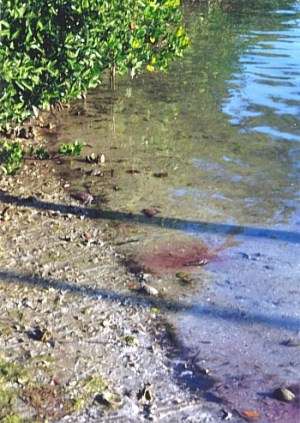
Bill,
As promised, here are some more photos of the Aplysia I found dying in large numbers. At top right is a photo showing purple ink spreading out from dying animals, and in the bottom left photo you can see the ink produced by one I have picked up. I hope they help you to identify it.
Anne.
adupont@gate.net


Dear Anne,
Thanks for the photos. In my separate message I discuss the problems with identifying west Atlantic Sea Hares. It seems that the general opinion is to identify your Sea Hare as Aplysia brasiliana. While Aplysia dactylomela from Florida, which you sent photos of today, is easily identifiable from its conspicuous black rings, there are many names available for 'dark' and 'mottled' species from the west Atlantic. Until someone studies living populations of these animals, it is going to be difficult to sort out how many species are found there and which names should be used. This is not a problem unique to the west Atlantic. The Indo-west Pacific species also have their share of nomenclatural problems.
My advice would be to cautiously use the name Aplysia brasiliana until a better solution is found.
Bill Rudman.
Aplysia brasiliana and swimming
September 9, 1999
From: Bill Rudman
In an answer to an earlier message on swimming Sea Hares in Florida I suggested the species was probably Aplysia brasiliana, based to some extent on Kandel's (1979) summary that Aplysia brasiliana was a swimming species. On reflection, and a search of the literature, I can find no reference to A. brasiliana being a swimming species. [Kandel also listed A. juliana, which I have never seen swimming, as a swimming species]. If A. brasiliana doesn't swim, what is the identity of these swimming Sea Hares from Florida? Any thoughts on the matter would be appreciated.
From Eales' (1960) revision I list the following swimming species:
•Aplysia depilans Gmelin, 1791 - East Atlantic. Grows to 300mm or more, swims.
•Aplysia fasciata Poiret, 1789 - East Atlantic. Grows to 400mm, swims.
•Aplysia willcoxi Heilprin 1886 - east coast of N. America from New England to the West Indies. Grows to 200mm long, swims.
•Aplysia morrio Verrill, 1901 - Bermuda and eastern US from Rhode Island to Florida, Texas. Grows to 400mm, swims.
•Aplysia gigantea Sowerby 1869 - Western Australia. Grows to 600mm , swims.
•Aplysia extraordinaria Allan, 1932 - eastern Australia, (& Hawaii?). Grows to 300mm, swims.
Reference:
Kandel, E.R. (1979) Behavioural Biology of Aplysia. San Francisco, W.H.Freeman&Co.463pp.
Bill Rudman.
Rudman, W.B., 1999 (Sep 9) Aplysia brasiliana and swimming. [Message in] Sea Slug Forum. Australian Museum, Sydney. Available from http://www.seaslugforum.net/find/1310Sea Hare West Palm Beach Florida
May 13, 1999
From: Kathy Dougherty
Bill,
Thank you for the sea hare info. It was interesting to know that other people have seen them. I have been diving here for years and had never seen one. If this is posted I would like to hear from anyone else who knows anything!
Thanks Kathy
CashmStd@aol.com
Dougherty, K., 1999 (May 13) Sea Hare West Palm Beach Florida. [Message in] Sea Slug Forum. Australian Museum, Sydney. Available from http://www.seaslugforum.net/find/859It would be good to add a photo of the Florida swimming Sea Hare to the Forum. If anyone can send me a scan, or lend me a print or a slide I would be grateful.
Bill Rudman.
Brown-winged sea slug from Florida
May 12, 1999
From: SB
On a recent trip to St. Augustine, Florida, my sister and her husband came across a type of sea slug that they would like your help in identifing this creature. It was brown (color of standard land slugs), with what could be called wings. It would "fly" in the water like a sting ray, buried itself in sand with a "air tube" sticking up through the sand. They also saw one that was injured and it omitted a purplish "ink". If you can help with this because the curiousity is killing us.
Thank you
Sherri
sherrib@citlink.net
SB, 1999 (May 12) Brown-winged sea slug from Florida. [Message in] Sea Slug Forum. Australian Museum, Sydney. Available from http://www.seaslugforum.net/find/856Dear Sherri,
There is a second message today about swimming Sea Slugs from Florida. It sounds like a Sea Hare and your mention of purple ink is a fairly definite confirmation that it is. The 'air-tube' you describe, is a good description, because it is the exhalant siphon which it uses to 'exhale' water from its mantle cavity in which the gill - which Sea Hares use to breathe - is situated.
Have a look at my answer to Esat Atikken's message which is also about a swimming slug from Florida.
If you have a look at the 'Sea Hare' topics listed in the General Topics Index you will find quite a bit of background information on these animals. In particular, have a look at the photos of Aplysia extraordinaria which is a swimming species from Australia, and shows the large parapodia used for swimming.
Any chance of a photo to put on the Forum?
Best wishes,
Bill Rudman
Re: Sea Hare? swimming in Florida
May 4, 1999
From: Esat Atikkan
Thanx for the information on the sea hare.
Regards
Esat Atikkan
atikkan@juno.com
Atikkan, E., 1999 (May 4) Re: Sea Hare? swimming in Florida. [Message in] Sea Slug Forum. Australian Museum, Sydney. Available from http://www.seaslugforum.net/find/840Sea Hare? swimming in Florida
April 27, 1999
From: Esat Atikkan
Sighted during night dive:
in ~ 70ft
West Palm Beach, FL
A. californica-like organism
Uniformly light-medium brown, swimming, sizes 10-20 cm. No markings. Encountered in 'swarms'; 100's of them swimming few cm to 10's of cm above the reef & reef bubble
Swims using mantles, in between of which is a bulbous structure.
Any help in ID will be appreciated
Esat Atikkan
atikkan@juno.com
Atikkan, E., 1999 (Apr 27) Sea Hare? swimming in Florida. [Message in] Sea Slug Forum. Australian Museum, Sydney. Available from http://www.seaslugforum.net/find/816Dear Esat,
It certainly sounds like a Sea Hare. Perhaps its Aplysia brasiliana which occurs in Florida.
A number of species of Aplysia can swim by flapping or undulating their large parapodia. Species I know about include:
Aplysia brasiliana (West Atlantic)
Aplysia depilans (East Atlantic)
Aplysia fasciata (East Atlantic)
Aplysia extraordinaria (east Australia)
Best wishes,
Bill Rudman.
